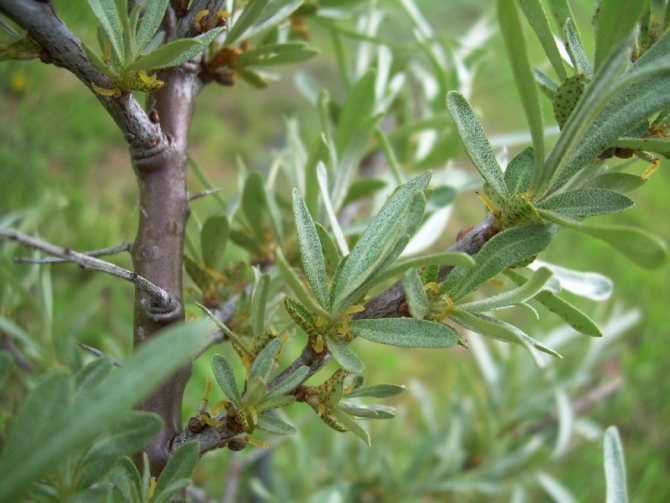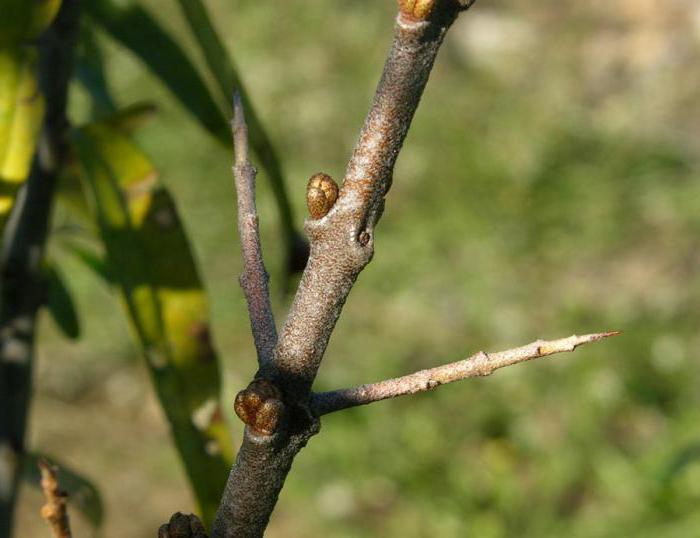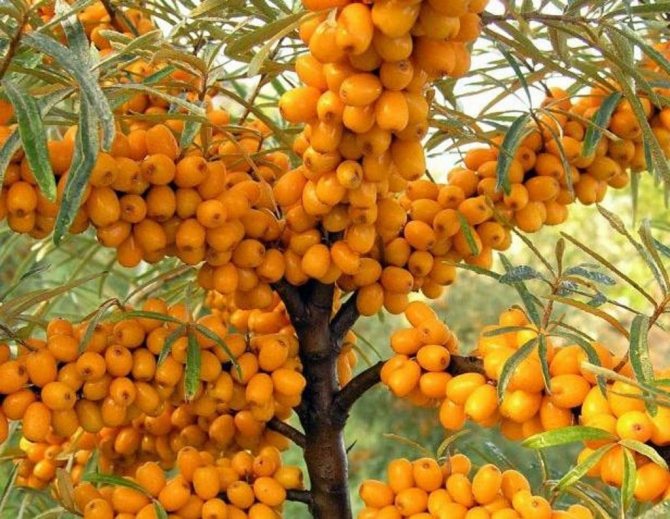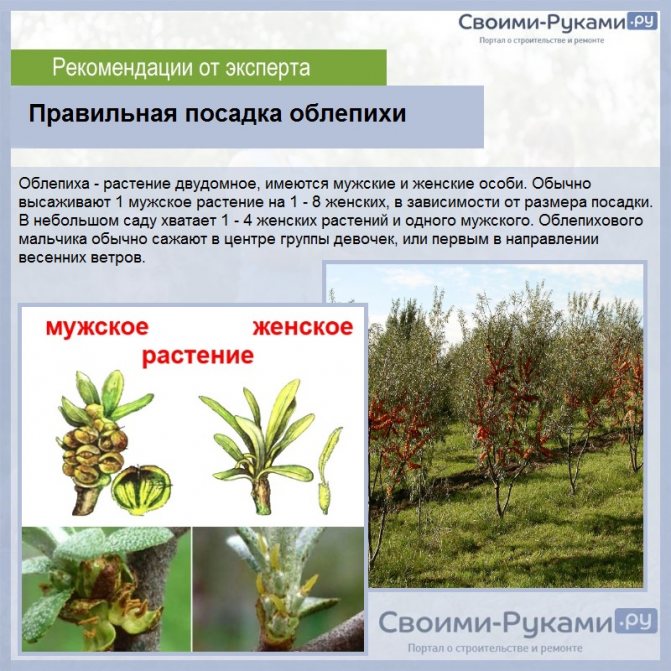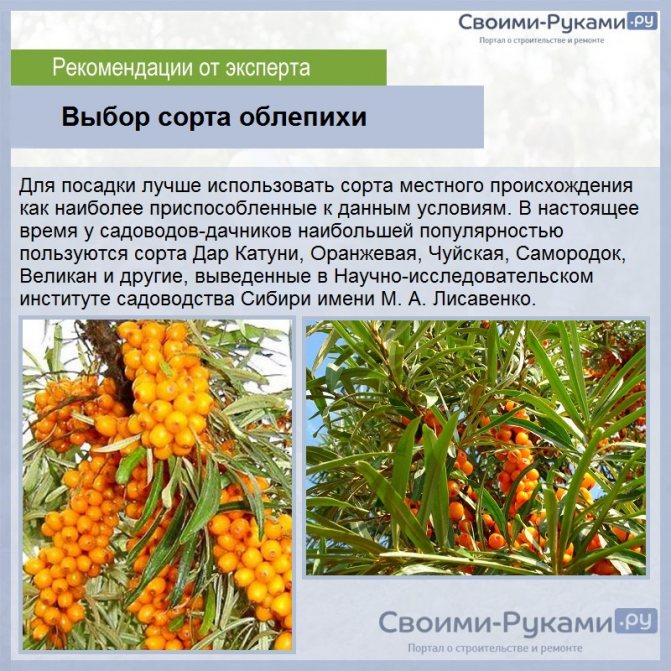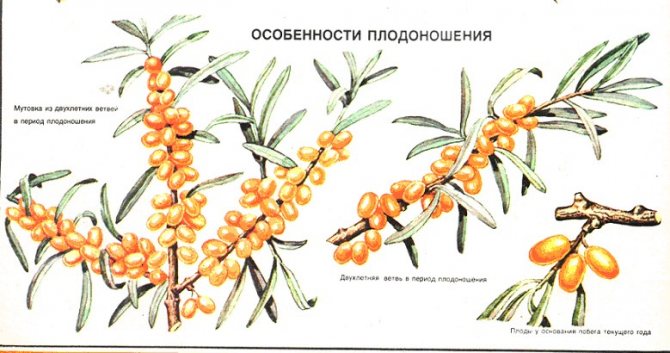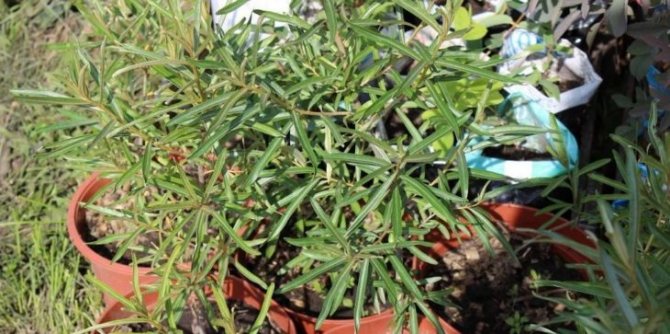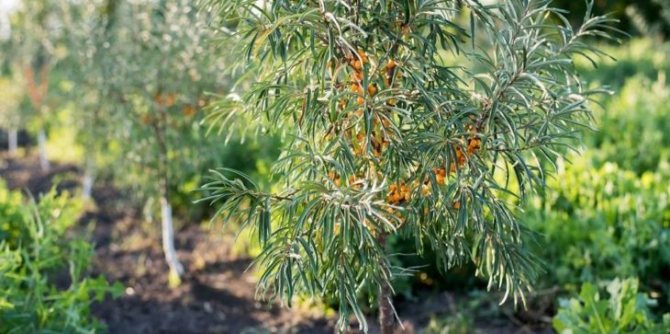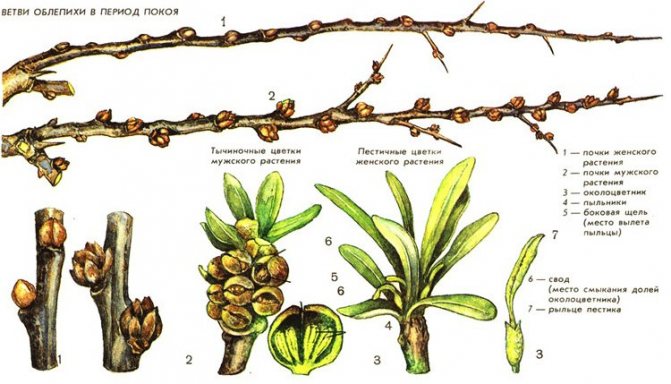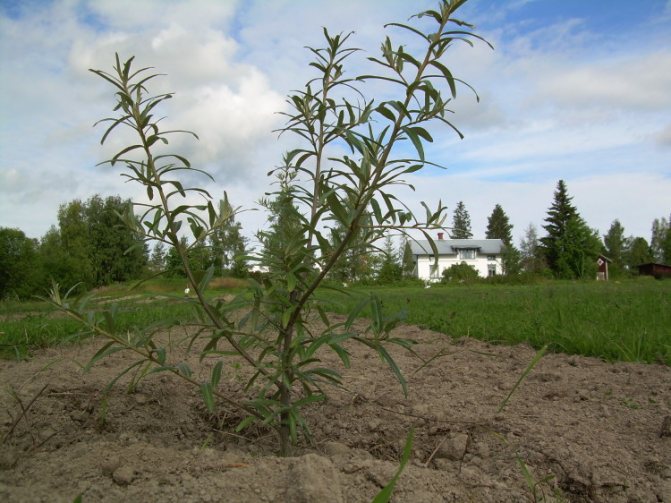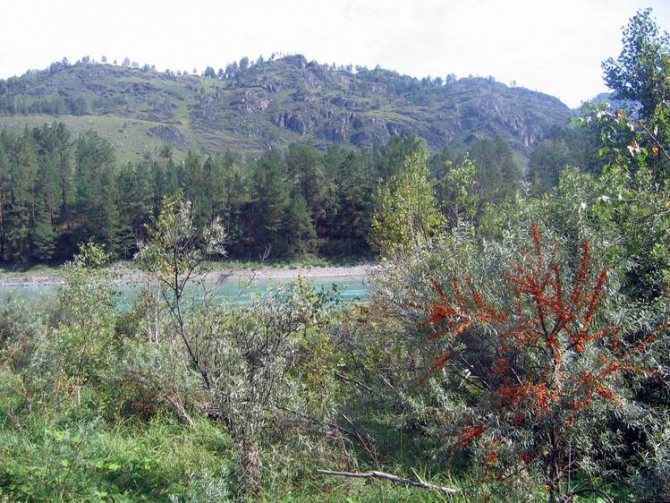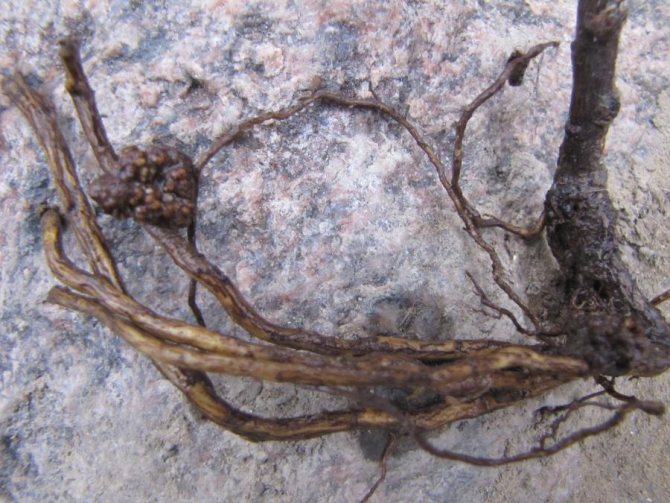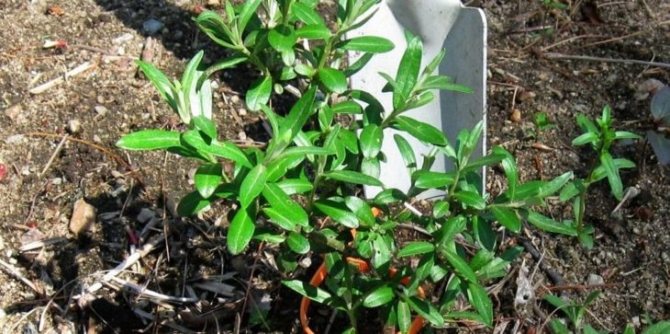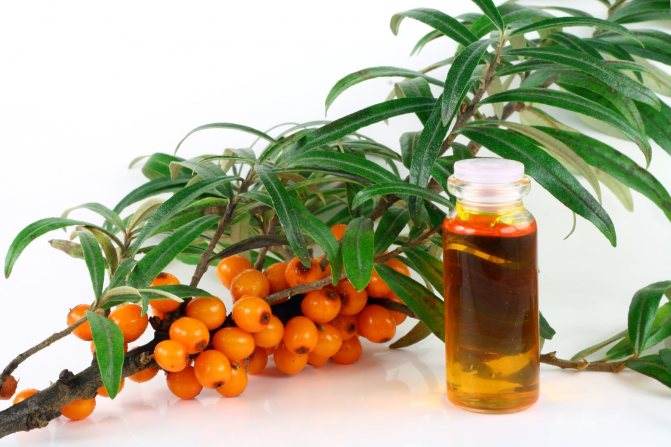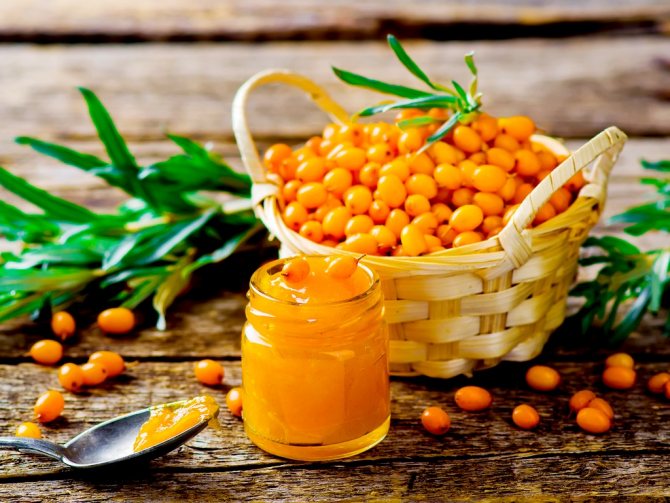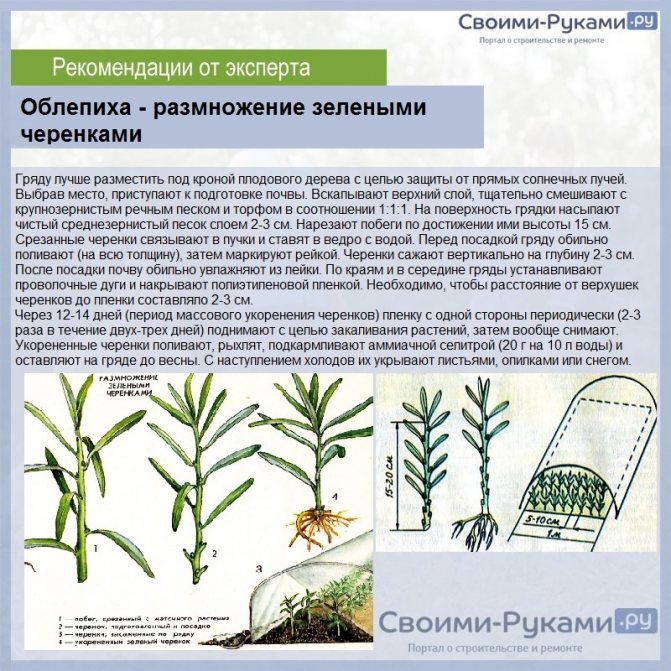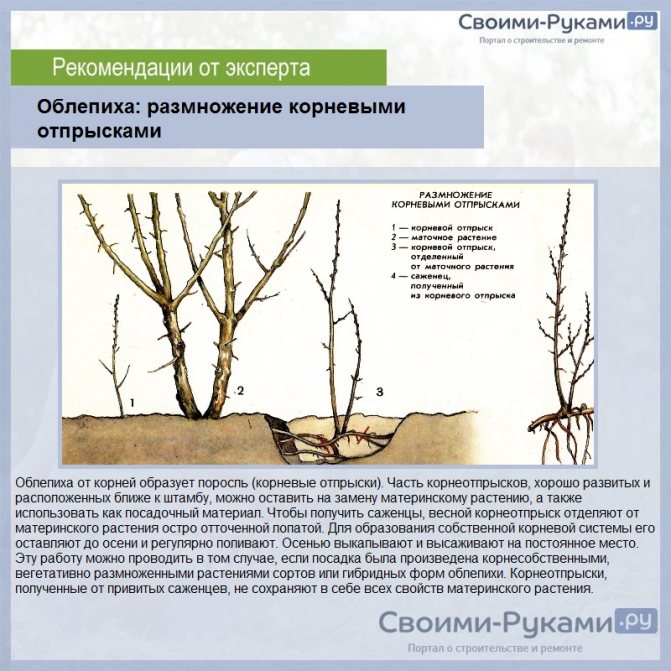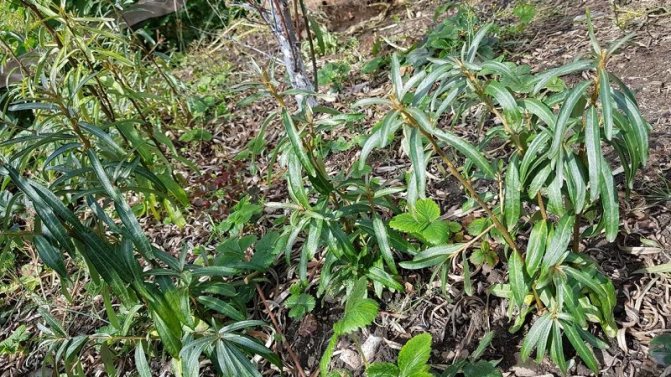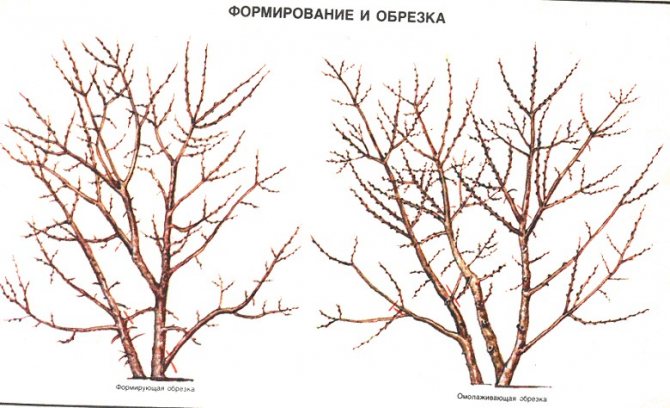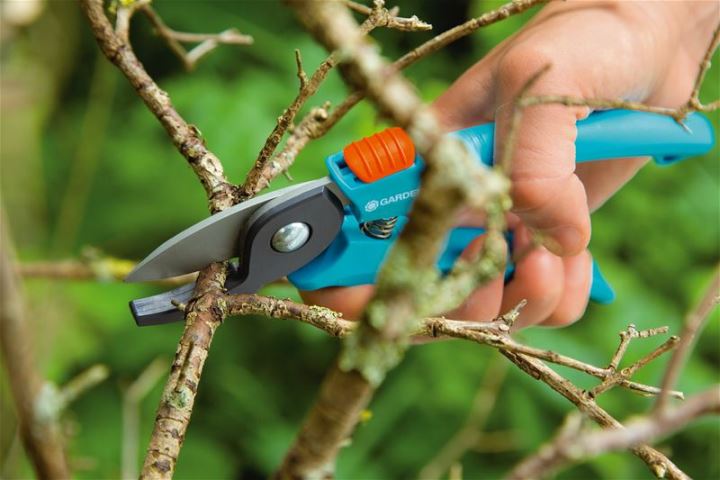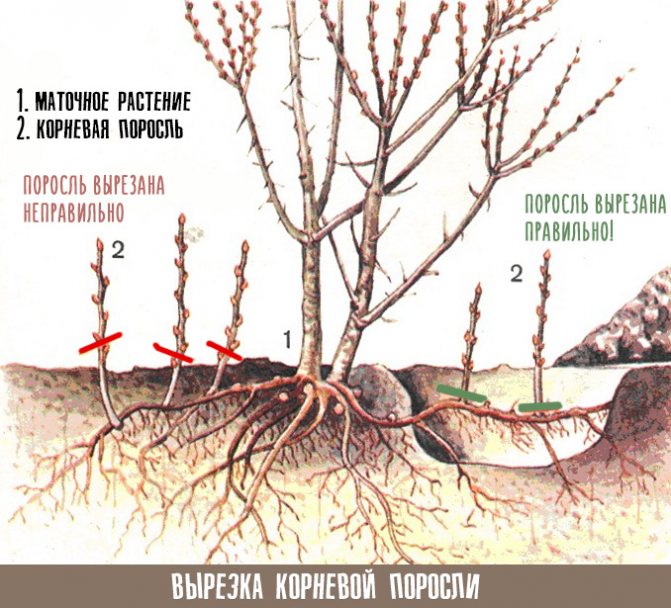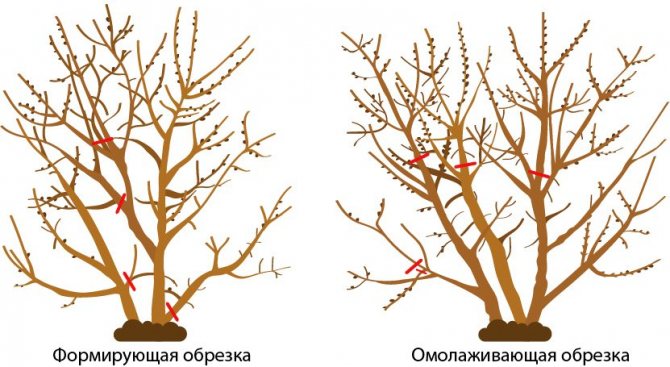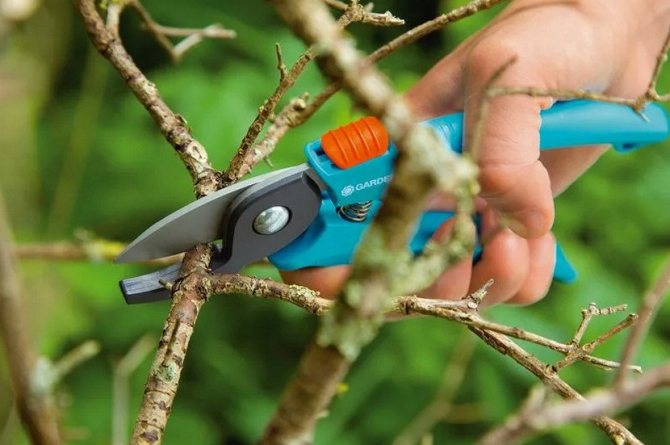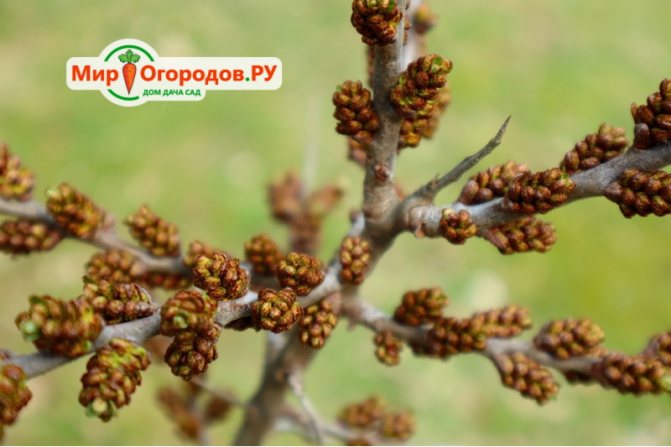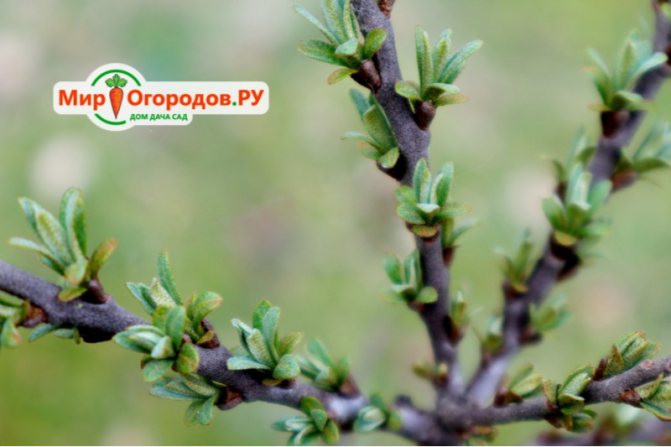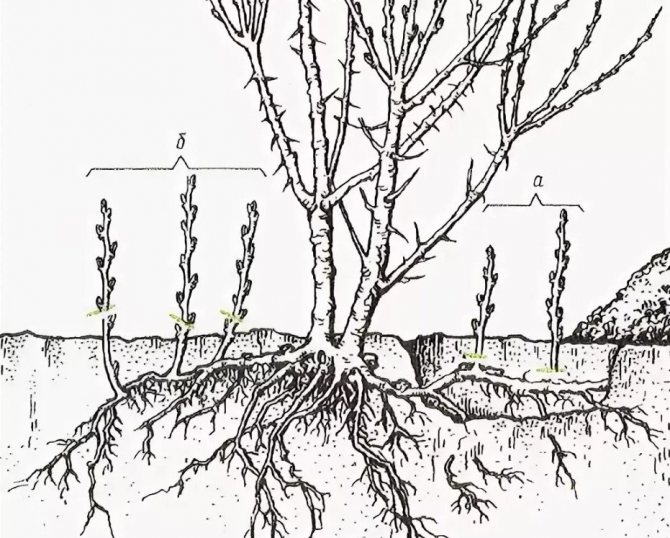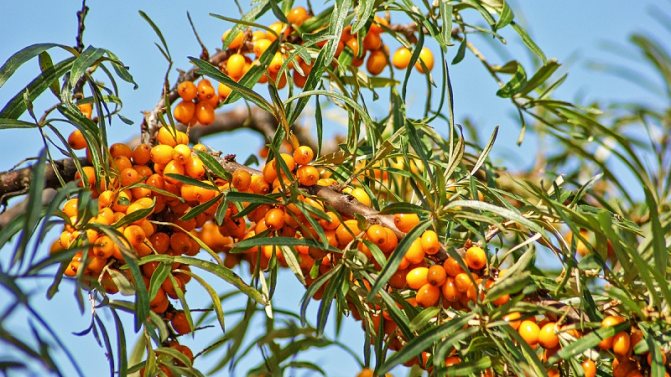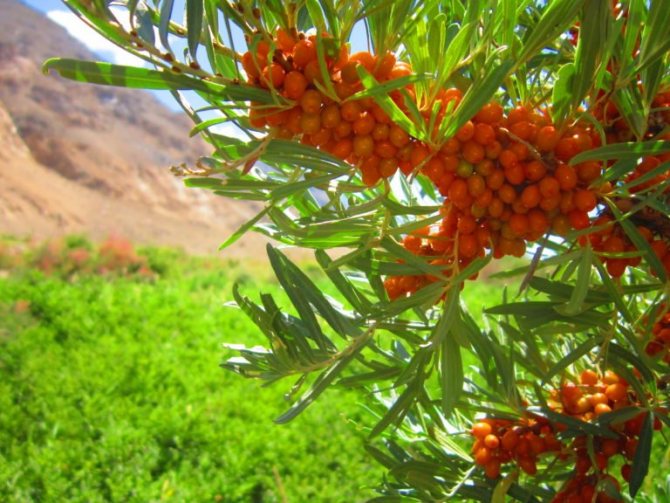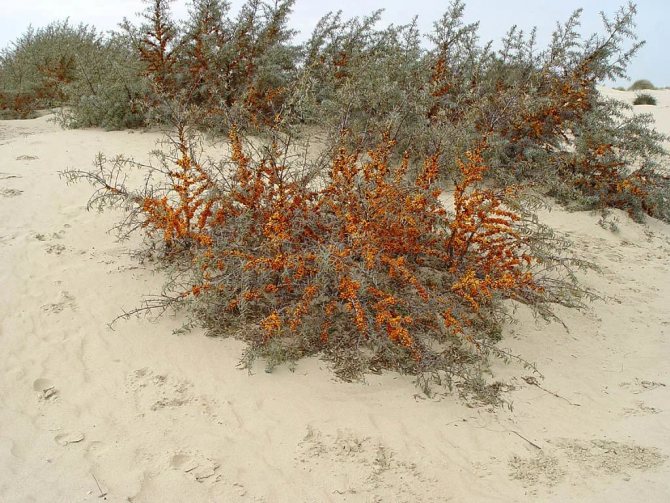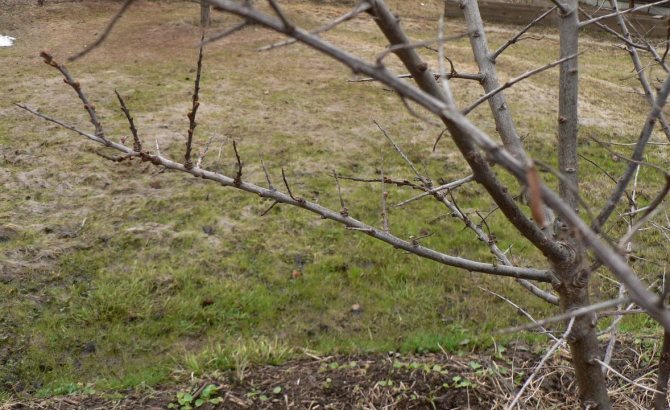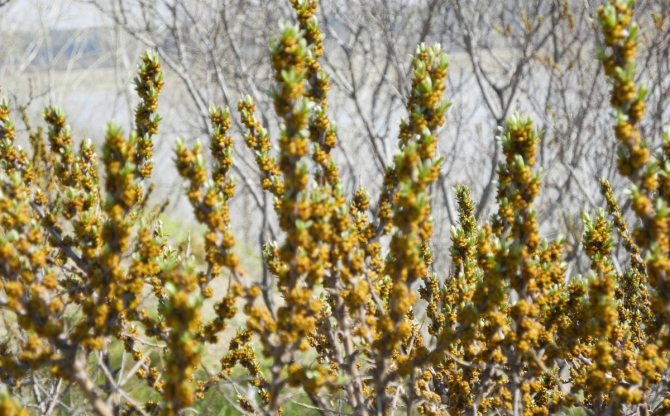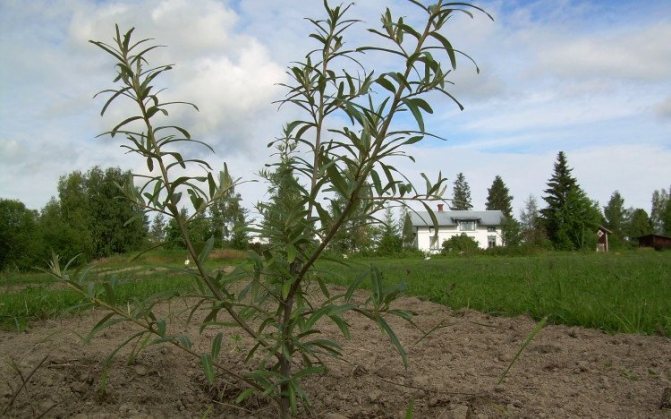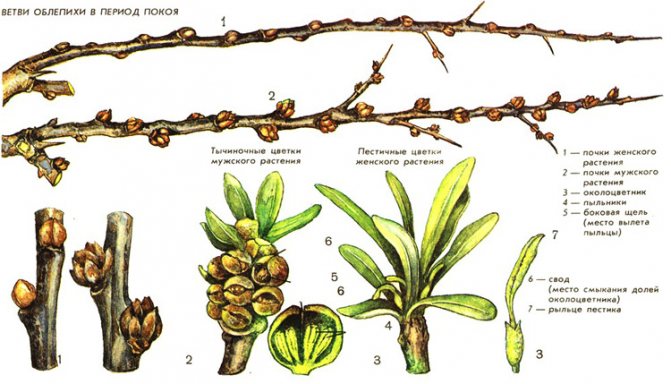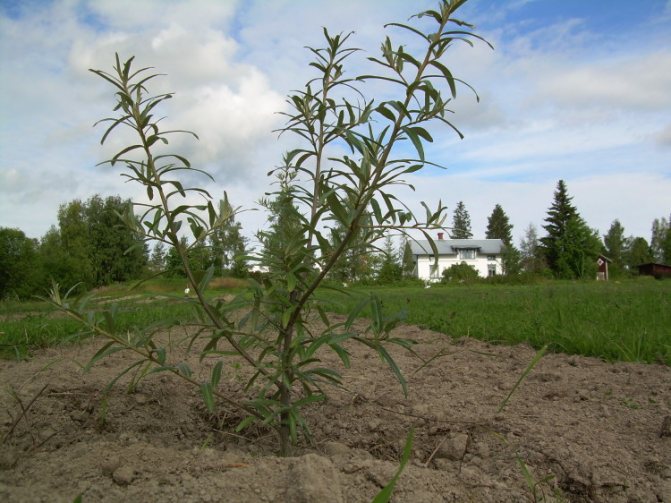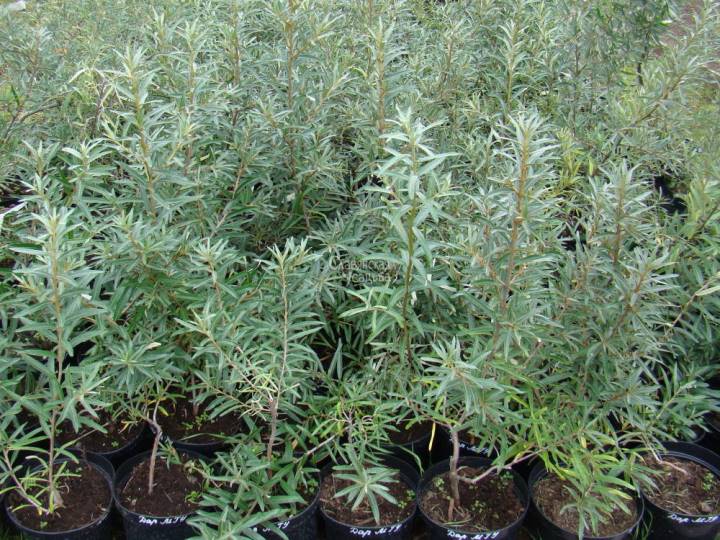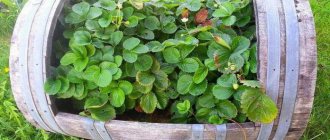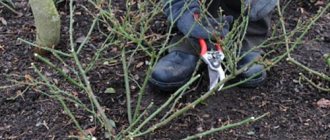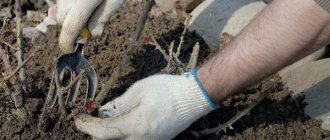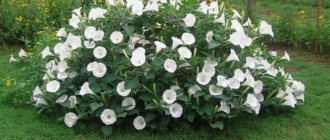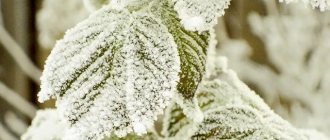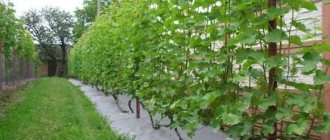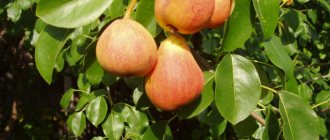Every year sea buckthorn gives a high yield of berries, but in order for this to happen, you need to select high-quality seedlings and understand the features of caring for them. For planting, medium-sized seedlings are needed, obtained by cuttings. This makes it easier to distinguish between seedlings and coppice plants.
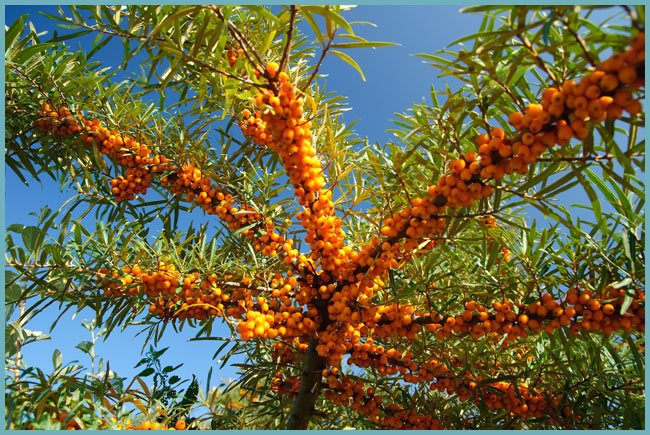
How to plant sea buckthorn
Pollination of sea buckthorn. Features of the
Sea buckthorn has male and female plant species, it is pollinated by the wind, so two seedlings should be planted close to each other. Distances of 5-10 m are enough for the plant to be well pollinated and bear fruit in the fall.
Correct planting of sea buckthorn
Female sea buckthorn plant
Sea buckthorn male plant
Gardeners advise planting one female plant and two male ones, since the male plant is more likely to die, and in general, two plants can pollinate a female seedling much better, there will be more berries, they will taste better. Male plants can be planted next to each other, at a distance of less than 1 m.
Choosing a variety of sea buckthorn
Sea buckthorn grade Chuiskaya
Sea buckthorn varieties: an overview
Over the past few decades, new promising varieties have been created that differ from the parental forms in an improved set of qualities. For comparison:
- Wild sea buckthorn berry weighs no more than 0.3 g, cultivated form - on average 0.5 g.
- If the old varieties gave no more than 5 kg of berries from the bush, then for new ones and 20 kg is not the limit.
Table: comparative characteristics of varieties
| Distinctive qualities | Variety name | Additional benefits of the variety |
| Large-fruited (berry weight from 0.7 to 1.5 g) |
|
|
| Yield |
| Favorite - high in vitamin E |
| High frost resistance |
| — |
| Thornlessness (almost without thorns) |
| Girlfriend - high carotene content |
| Increased oil content |
| — |
Sea buckthorn is a culture with a unique biochemical composition, its ripe fruits contain a whole range of vitamins. Separately, it is worth noting the varieties with the largest amount:
- vitamin C - Red torch, Atsula, Ayaganga;
- vitamin E - Amber.
Gallery: the best varieties of sea buckthorn
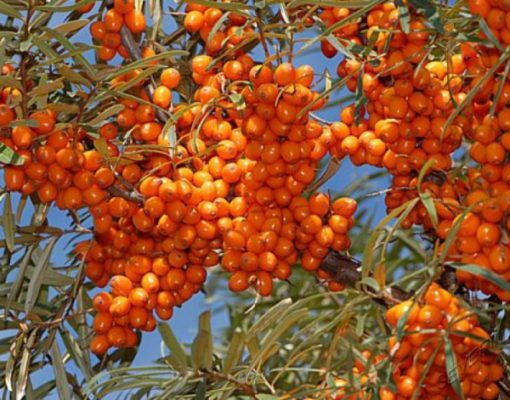

Large-fruited sea buckthorn variety Elizaveta is characterized by persistent immunity to pathogens
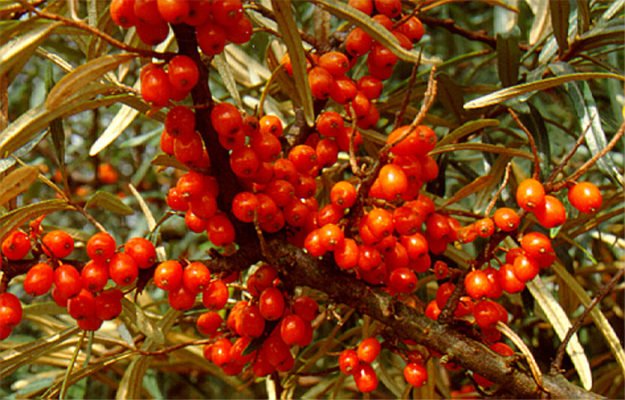

Sea Buckthorn Jam is able to withstand even 40-degree frosts
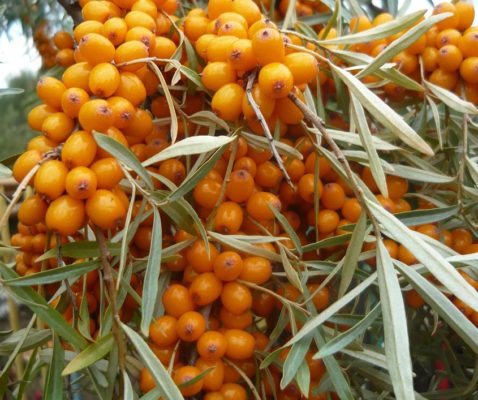

The sea buckthorn Giant has almost no thorns on its shoots, which greatly facilitates picking berries
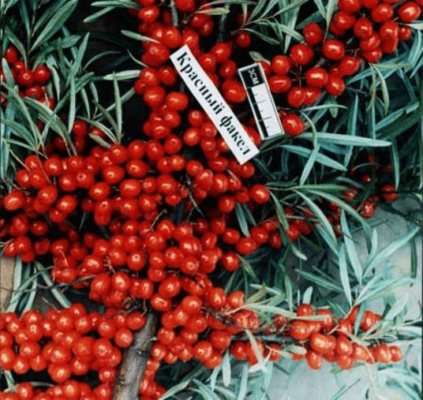

A new variety of sea buckthorn Red Torch contains an increased amount of carotenoids and vitamin C
Cultivated varieties have large fruits and long stalks, which greatly facilitates harvesting.
Video: Chuiskaya sea buckthorn variety
When is the best time to plant and transplant sea buckthorn?
Early spring is considered the most favorable time for plant transplantation, the earlier the better.She does not survive the winter well if the conditions are not the most favorable. For example, the thaw period has a negative effect on the shrub, the vegetation begins early in the sea buckthorn.
An earlier transplant is needed for plants with an open root system, as well as individuals that can damage or lose the root system or part of it during excavation.
It is better to plant sea buckthorn in spring
Planting a seedling from a container into the ground is an easier process, but only if the plant has existed in the container for a year or more. In this case, its root system is resistant to soil, it is hardened by not the best conditions and will perfectly “get over” the period after planting.
Even if you do not have the opportunity to plant sea buckthorn in the spring, then try to do it in the summer. Some people prefer the autumn period, after harvesting, but in this case, the root system of the plant simply does not have time to get stronger before the cold weather approaches. This could injure him.
Landing dates
Exact the dates of planting in the ground depend on the climatic conditions of the region:
- Siberia, Ural, St. Petersburg - all September.
- The middle lane (Moscow region) - late September - early October.
- Krasnodar Territory, North Caucasus - all October.
When is the best time to plant - in spring or autumn
You can plant sea buckthorn at any time - in spring, autumn, summer.
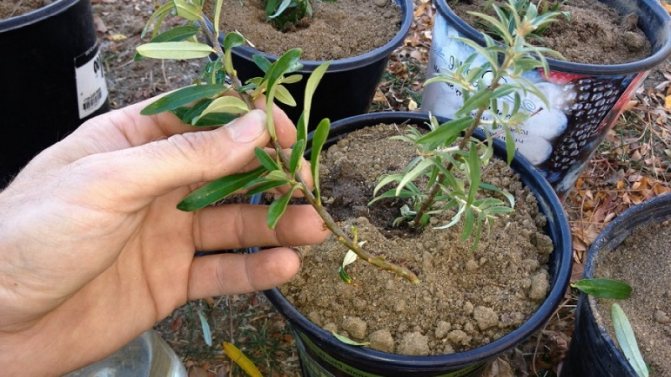

The best time for planting is spring, before sap flow begins.... The seedling will have time to grow stronger before the onset of cold weather. It's March - April.
In autumn, plants with a closed root system are planted.... In terms of time, this is the end of September - October. An important condition is the temperature above + 4 ° С.
Choosing a landing site
Sea buckthorn is planted in the garden or in the vegetable garden. If you are planting plants in your garden, you need to be careful not to get too close to the planting area. The garden soil is not quite suitable for this type of shrub, and the sea buckthorn itself, with its roots branching many meters around itself underground, can cause damage to plantings. They do not lie very deep, only 20-30 cm deep, which makes the root system easy to damage. Sea buckthorn does not tolerate root injuries, it begins to hurt.
Sea buckthorn seedling in the garden
Important: Plant the plant in a place where you will not need to work and dig up the soil around it. Most often, sea buckthorn is allocated a plot at the edge of a garden or vegetable garden - near a fence or next to buildings.
It is also necessary to monitor whether the plant receives enough light. You should not plant it in a place where the sun does not fall, sea buckthorn needs light, darkened places do not suit it.
Sea buckthorn grows well in the sun
Crown formation
Sea buckthorn can be formed with a bush or tree. After planting a seedling, in order to get a bush in the future, it is cut off, leaving a cut of about 20 cm. 3-4 shoots are left from the shoots that appeared later. The excess is cut out as low as possible on the ring, digging out the root. This operation is only possible with non-grafted specimens.
You need to act carefully, since sea buckthorn does not tolerate interference in the root system, it can dry out from improper handling.
In order for a single-stemmed tree to develop, a low stem is left (about 30 cm). The low height contributes to the formation of a narrow crown, which is easy to care for and harvest. 3-4 large branches are left on it. The central conductor is left for the next season.
Of the shoots that have appeared, 3-4 are left again. The tops equalize everyone. Strongly growing branches are shortened during the second and third years. Next, you need to be careful, because flower buds are laid on the tops of the branches.
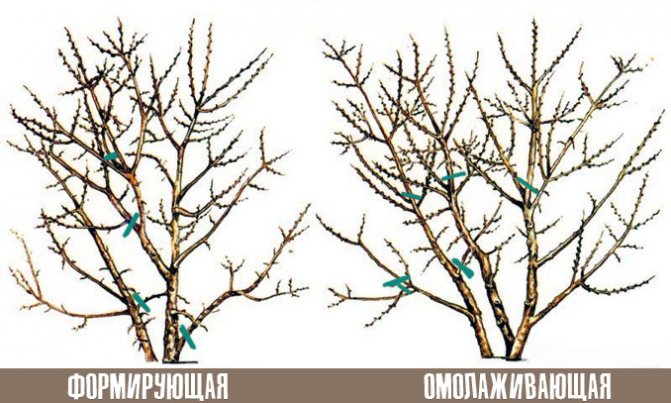

How to transplant an adult sea buckthorn?
Planting sea buckthorn is a simple process, since in its structure it has almost no differences from other fruit plants. Some gardeners like to use a lot of fertilizers, which does not in the best way affect the life of the plant in the future. Do not overdo it with organic and mineral fertilizers, a bucket of compost will be enough (for transplanting, if you are planting a young seedling, there will be a lot), superphosphate (if the soil in your area has the ability to acidify, then use double superphosphate).
Superphosphate double granular
If desired, you can use a compound fertilizer, although this is not the most useful option.
When transplanting sea buckthorn from one place to another, it is necessary to carefully dig out the main part of its roots. Since they are very long, several meters in length, it is unlikely that it will be possible to dig up the plant without damaging the roots at all. So that in a new place the sea buckthorn takes root better and does not start to fade due to a damaged root system, it is worth cutting off part of the above-ground area of the plant. Of course, this will reduce her ability to bear fruit this year, but in the future such a measure will be useful.
How to use and prepare it
The sour, characteristic taste of fresh berries is not to everyone's liking. What can be done with sea buckthorn so that all households love it?
- to freeze. So the berries can be stored all year round, and after defrosting they will acquire a completely different, pleasant, sweetish taste. They can be used to make sauces and pie fillings;
- cook compote. You can drink it fresh, or you can close it in tanks and sterilize them for a few minutes, then it can be stored all winter. In the same way, sea buckthorn puree or jam is prepared;
- make wine. Such a treat has a wonderful aroma and properties useful for digestion, it will be appreciated by your guests and loved ones.
But sea buckthorn oil has truly miraculous properties. Experienced gardeners make it themselves from ripe berries. Take care of your garden, and he will certainly thank you with a bountiful and healthy harvest.
Planting young seedlings
Sea buckthorn - propagation by green cuttings
If the plant is already large and has many branches on the sides, then they can be removed, thus making life easier for the tree. Leave only the main trunk, it will quickly overgrow with new branches.
It is ideal to plant sea buckthorn at a distance of 1-1.5 m from the border of the site, the rows between the sea buckthorn bushes should be 2x2 m.The pit for planting should be 30-40 cm deep and 50 cm in diameter.The bottom of the hole should be laid out with broken brick, shell and crushed stone, the layer should be about 10 cm. On top of this layer you need to pour fertile soil, and above - fertilizers (do not overdo it).
A young seedling must be at least two years old. It is worth planting it straight, it is best to first place a stake in the pit, which will serve as the basis for the correct installation of the seedling. If you initially plant the tree incorrectly, then later the trunk can be very curved, which will lead to the fact that the tree may be damaged in the future.
A newly planted tree should be watered abundantly and the soil at its base should be compacted.
Young sea buckthorn plant, 1 month after planting
Sea buckthorn: propagation by root suckers
When and how to harvest in the fall?
Harvesting takes place from the second half of August to the end of September. The exact time depends not only on the sea buckthorn variety, but also on how the berries will be used in the future:
- fresh or frozen - pick berries at the beginning of ripening, when they have a dense skin and contain the maximum amount of vitamin C;
- for making sea buckthorn jam, juice or marmalade - pick berries in the second half of September, when they become soft;
- for the preparation of sea buckthorn oil - pick the berries a week after they have acquired a soft consistency, but they should not be overripe, since in this case they will burst when trying to tear them off the stalk.
In order for the shrubs to remain healthy and be able to bear fruit abundantly next year, first of all, it is necessary to correctly collect the fruits, which is a rather laborious process and can be done in several ways:
- Pick the berries by hand by cutting them off the branches with small scissors or tongs. You can first cut off a whole branch, and then disassemble the berries at home, however, in this case, you can damage the plant and it is unlikely that you will be able to immediately cut off all the branches with fruits. This method will take a lot of time, but it will allow you to collect sea buckthorn as efficiently as possible.
- Cut branches with berries from the bush and freeze them. In this form, it is quite easy to tear the berries from the branches. This method is mainly used when the fruits are planned to be stored frozen.
- Pick the berries off the stalk with your hands, but act carefully so that the soft skin of the fruit does not break off and the juice does not flow directly onto your hands.
- Place a container for juice under the branch of a bush and slowly move your hand along the branch from base to tip, actively crushing the berries. The method is used to extract sea buckthorn juice directly from the bush. You can squeeze out up to 4 liters of juice per hour.
- With the first frost, spread an awning under the bushes and shake the plant. The method is used when picking ripe berries very late for the preparation of sea buckthorn oil.
Prolonged contact of the skin of the hands with sea buckthorn juice can provoke severe irritation, therefore, rubber gloves should be used when harvesting.
If sea buckthorn is collected in large quantities in autumn, then it is more expedient to use special devices for this purpose:
- Cobra... A popular folk instrument made with a piece of wood and steel wire. A handle is made of wood, and a loop is made of wire, resembling the wick of a hot candle in outline. With the help of an awl, you need to attach the loop to the handle, getting a structure that resembles a snake. With such a device, you can easily and quickly get berries by cutting off their stalks. They can reach even the most inaccessible places in the bush.
- Scraper... It is made of steel wire, covered with an aluminum sheath, about 50 cm long. In the middle of a piece of wire, make one curl like a spring. To do this, the wire can be wrapped once around the neck of the glass bottle. Align the ends of the segment and bend to one side at an angle of 90 degrees. Using such a tool, it will be possible to easily press the twig and peel the berries from it, simply by moving the scraper down.
- Tubule... A tin can is used for its manufacture. From it you need to cut a blank, which is twisted into a tube. Its optimal length and diameter is 100 mm each, so that it exceeds the size of sea buckthorn berries by about 4 mm. Wrap the resulting tube with electrical tape, leaving a little space at the edges, and attach a plastic bag to it from below. The finished device must be brought to the stem with its upper part and slightly pressed. The cut berry will roll down the tube into a bag intact and safe.
- Slingshot... It is required to make a slingshot with a string from a fishing line. Holding the branch with one hand, the other needs to cut the berries from it using a homemade slingshot.
With the help of such devices, you can collect up to 10-15 kg of sea buckthorn berries.
How is sea buckthorn fertilized?
After planting itself, you do not need to be zealous, fertilizing the soil. At this time, the plant needs rest, and unnecessary actions can disturb it. Make sure that the sun is enough, clear the land around the sea buckthorn from weeds, the rest will be done by nature.
If your plant is already several years old, then there are certain fertilization and feeding schemes for sea buckthorn.
Some people are used to liming the soil before planting sea buckthorn, the dosage of lime depends entirely on the type of soil in your garden. But for all plants there are certain norms of nutrients that they must receive regularly.
We fertilize the soil according to the scheme
There is a scheme for fertilizing the soil in accordance with the goals of obtaining a certain amount of fruit.
An excellent way to fertilize sea buckthorn in spring and autumn is with a garden drill. With this device, holes are made 40 cm deep, between the roots of the tree. In this case, the distance from the trunk should be equal to 1 m. The hole is covered with pebbles and gravel, after which fertilizers can be supplied through it and filled with water. Thus, the minerals will seep much deeper into the ground, due to which the plant will be nourished and filled with energy.
There are certain rules for using different types of fertilizer for sea buckthorn.
- It is customary to use phosphorus-potassium fertilizers in the autumn, next to the active roots of the tree. If your garden is not very large, then, most likely, the accumulation of active roots is located at the trunk of the sea buckthorn.
Important: Phosphorus is necessary for sea buckthorn more than other substances, since it helps the formation of nodule bacteria that form on the roots.
Females require more care and, accordingly, they should be allocated more fertilizer. Male plants are more unpretentious, they can grow in dark areas, in dry soil, and so on. But this does not mean that they do not need care - they do, but it can be less thorough.
Video - Secrets and subtleties of growing sea buckthorn
Agrotechnical cultivation
It is not difficult to grow sea buckthorn, the main thing is to create comfortable conditions for it.
Recent Entries
Rose Petal Jam and Its 7 Health Benefits You Likely Didn't Know About What Fruit Are You According to Your Zodiac Sign 11 Best Grape Varieties That Will Help You Create Unique Homemade Wine
Top dressing
In the first year after planting, the young do not need additional nutrition, but starting from the next spring, feeding is carried out several times per season:
- In spring, shrubs should be fed with nitrogen fertilizer for intensive growth of vegetative mass. A solution of urea (20 g / 10 l) is brought under the bush.
- After flowering and after 10 days, foliar feeding is carried out with Effekton (15 g / 10 l).
- Fruiting plants are sprayed with a urea solution (15 g / 10 l) during the leaf blooming period.
- During flowering, a solution of potassium humate (15 g / 10 l) is introduced on the leaf.
- After harvesting, to restore strength, the plant is fed with superphosphate (150 g / m2) and potassium (50 g).
- Organic fertilizer is added every 3 years in the fall, embedded in the soil (10 kg / m2).
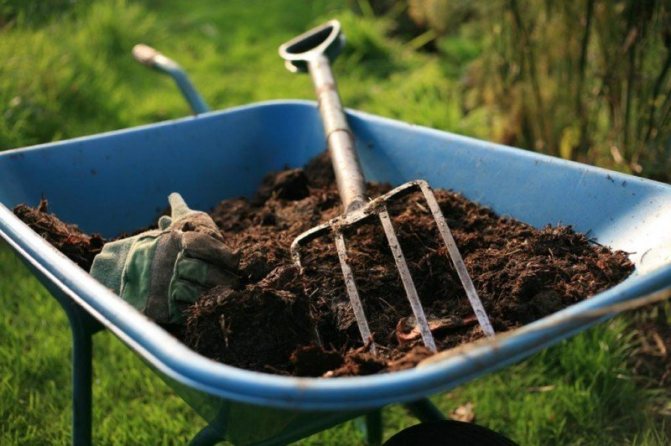

Humus is added every 3 years - this is enough to saturate the sea buckthorn with the necessary nutrients
Sea buckthorn especially needs phosphorus, which ensures the vital activity of root-nodule bacteria.
Watering and loosening
Sea buckthorn is not afraid of drought, but in extreme heat it needs watering. Moisture is especially necessary for young seedlings - they are watered at first every day, spending 4 buckets of water per bush. The soil should be moistened to a depth of 60 cm. For fruiting bushes, 4 waterings per season are enough (6 buckets per plant):
- before and after flowering;
- during the period of fruit formation;
- before the onset of cold weather (late September - early October).
Pre-winter watering is very important: if enough water has not been accumulated in the autumn, the cold resistance of the plant is greatly reduced.
After watering or rain, be sure to loosen the soil.Since the roots of the bush are located superficially, loosening the soil under the bush is carried out shallowly (7 cm), in the aisles - 10 cm. If the roots are exposed, they should be mulched with a mixture of peat and sand.
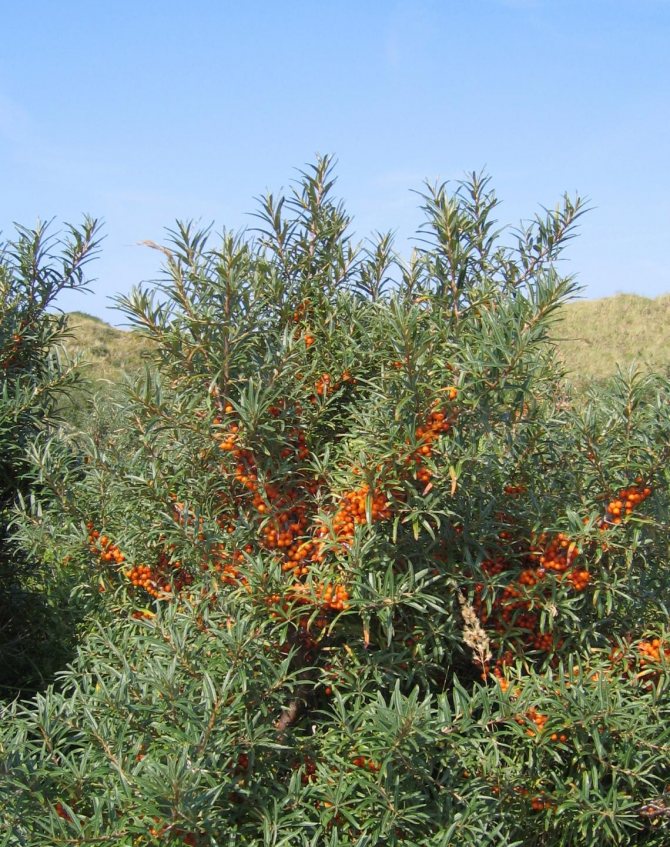

An adult sea buckthorn plant is not afraid of drought, but the yield will be more abundant if the soil is well moistened during the period of fruit formation
Video: how to care for sea buckthorn
Prevention and treatment of lesions
New varieties of sea buckthorn have good immunity, however, under unfavorable conditions, the plants may show signs of pest or disease infestation.
Table: signs of diseases of the sea buckthorn bush, prevention and control measures
| Diseases | How do they manifest | Prophylaxis | Measures |
| Verticillary wilting |
|
| Cut out the affected branches, since the disease is incurable. |
| Septoria | Infection occurs in warm, humid weather. Bushes are maximally affected at the stage of fruit ripening, the disease manifests itself as follows:
|
|
|
| Endomycosis |
|
| Before bud break, spray with 2% Nitrafen solution. |
Photo gallery: sea buckthorn diseases


When infected with septoria, the foliage on the sea buckthorn dries up, the shoots turn brown
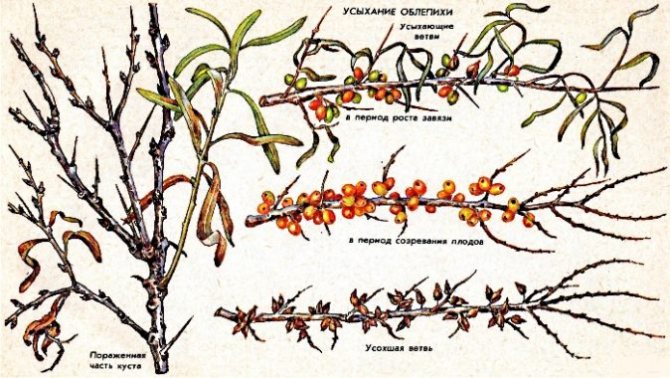

Verticillary wilting can appear on sea buckthorn bushes in the second half of summer.
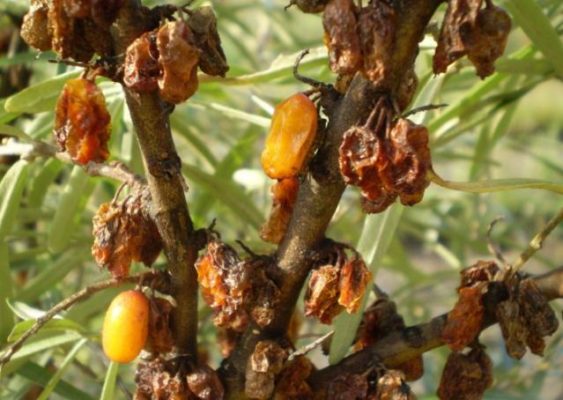

With endomycosis, the pulp of the fruit softens and flows out of the shell
Table: what insects harm sea buckthorn
| Pests | Infection characteristic | Prevention measures | How to help |
| Sea buckthorn fly | A very dangerous pest that destroys up to 90% of the crop. The fly pierces the skin of the green fruit and lays an egg. The larva feeds on the pulp of berries. |
|
|
| Green sea buckthorn aphid | Aphid colonies suck sap from young foliage. Damaged leaves curl, turn yellow and fall off. | Destroy fallen leaves on which aphids settle. |
|
| Sea buckthorn moth | The pest lays eggs on the sea buckthorn bark. In the spring, caterpillars penetrate the kidneys. With a massive defeat, the plants dry out. | Remove fallen leaves, loosen the soil where moth eggs hibernate. | At the beginning of bud break, spray with a solution of Metaphos (3%), Entobacterin (1%). |
Photo gallery: sea buckthorn pests
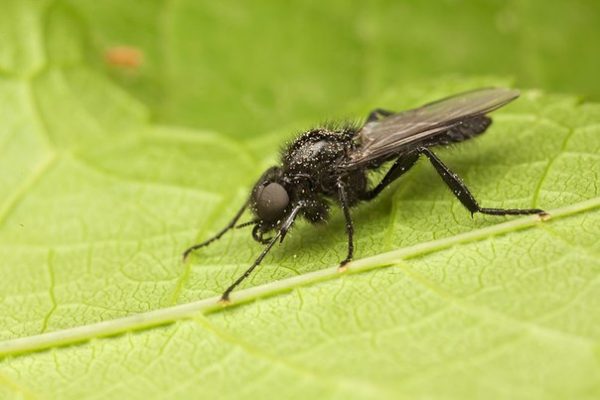

The worm-like larvae of the sea buckthorn fly can destroy almost all crops on the plantation
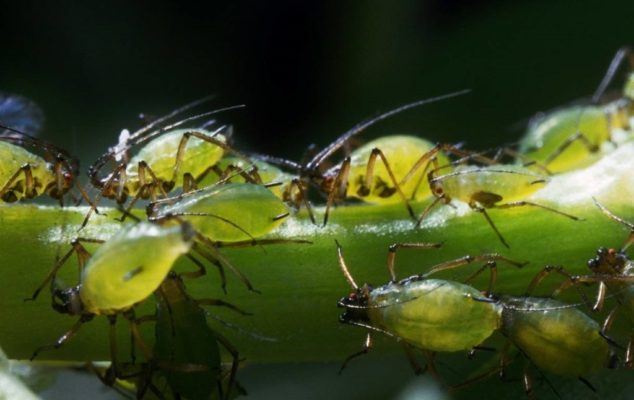

Green aphid larvae hatch in mid-May and suck the juice from young leaves
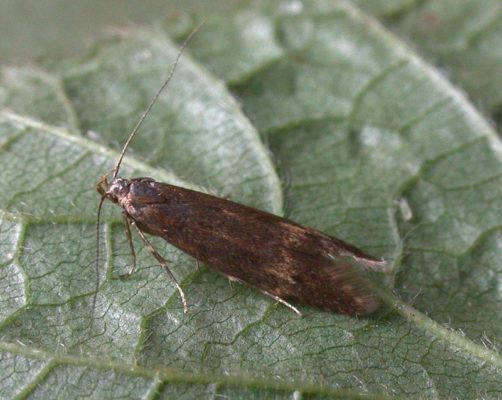

Sea buckthorn moth lays eggs on the bark of the lower part of the sea buckthorn trunks, fallen leaves and soil
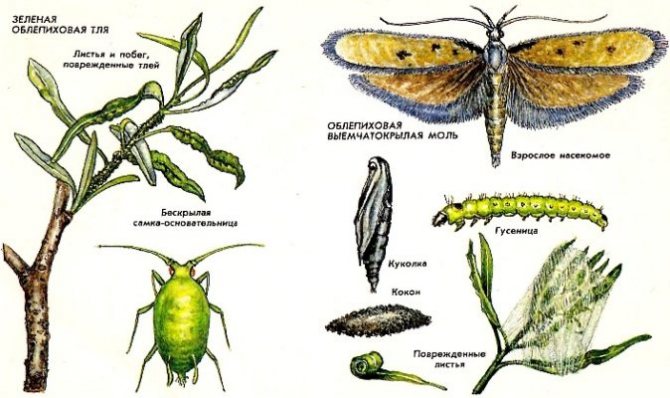

When damaged by pests, the leaves curl and dry out, the plant is greatly weakened
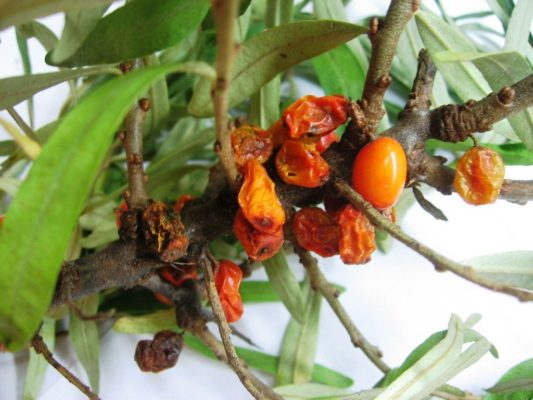

Fruits affected by sea buckthorn fly deteriorate and dry out
Grafting sea buckthorn
The easiest way to plant sea buckthorn is cuttings. They do it as follows:
- 5-10 young shoots are selected on the plant, from which cuttings are cut. The length of the scion should be 10 cm.
- In the swelling phase of the buds, the grafting is done in a large branch located on the sunny side.
- All cuts should be done with a sharp knife and must be covered with garden pitch.
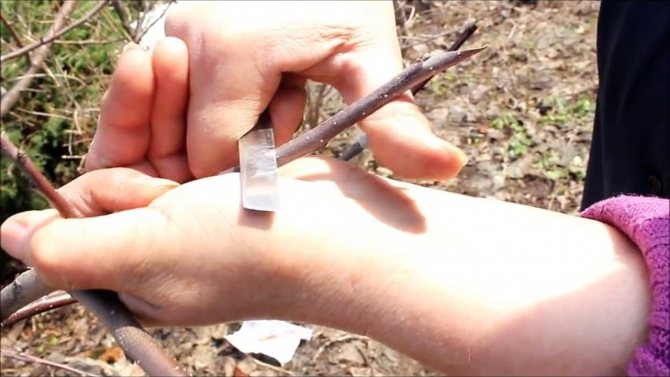

The wood of the sea buckthorn is loose, so all cuts should be done with a sharp knife.
- The vaccination site is tied with a film.
It is better to inoculate with a kidney into the root collar itself from the convex side. There the bark is more elastic and fusion is faster.
Video: grafting a pollinator onto a female sea buckthorn plant
Preparing for winter
Sea buckthorn is a winter-hardy culture that can withstand even severe frosts, therefore it does not need insulation. However, it has fragile wood, which easily breaks under the weight of large drifts of snow. In heavy blizzards, shake off snowballs from the branches.
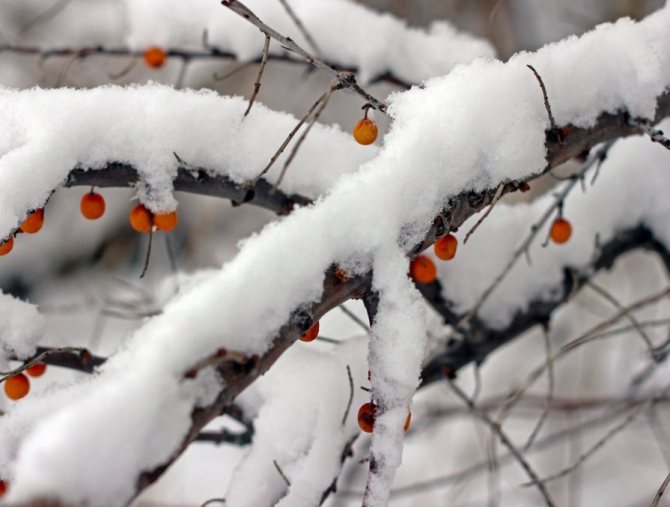

After snowfalls, you should shake off the snowballs from the branches so that they do not break.
Sea buckthorn is not damaged by spring frosts. Warm, damp weather in winter is more dangerous for her, when the soil does not freeze and, as a result, the bark of the trunks at the root collar often looses out. Also, winters with little snow or sudden temperature changes from + 4 to -30 degrees have a negative effect on the plant: branches are damaged and dry out, yield decreases. To mitigate the negative impact of a sharp change in temperature, watering is carried out on frozen ground in mid-November, and then a layer of peat or humus mulch is laid.
Pruning
After planting, the top of the seedling is pinched to get a branchy bush in the future with a stem height of about 20 cm. Sea buckthorn grows very quickly, a whole clump soon forms from a small bush. With age, many branches dry out, making it difficult to harvest. Fruiting moves to the periphery of the crown. Adult sea buckthorn bushes are pruned as follows:
- To form the crown in early spring, remove excess, improperly growing branches, cut off root suckers at the base.
- Bushes over 7 years old need anti-aging pruning. Old branches are removed, replacing them with 3-year-old side shoots.
- In autumn, sanitary pruning is carried out, ridding plants of dry, broken and disease-damaged branches.
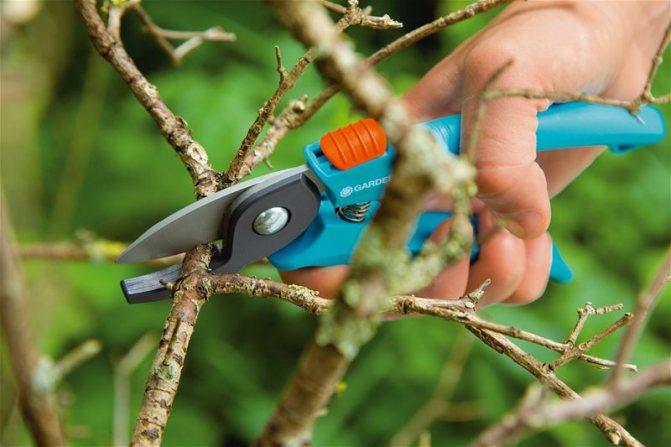

With proper care and timely pruning, sea buckthorn grows and bears fruit for many years
Video: spring pruning sea buckthorn
Further care of the plant
In the spring, before the first buds bloom, you need to form sea buckthorn bushes, giving them the desired shape, cutting off unnecessary branches. This should be done a year or two after planting, since the aerial part of the tree during this period is already well formed.
More attention should be paid to 4-5 year old trees. During this period, there is no need to spare the fruit-bearing branches, the excess weight of the aboveground part interferes with the tree. It is best to remove shoots that grow parallel to the trunk, and it is also imperative to prune dry branches.
Shaping and pruning
In older plants that bear fruit for 8 years or more, a period of diseases may begin, the branches dry out, and the fruits become less strong, which can lead to a pest attack on the plant. There are anti-aging pruning techniques that can help bring sea buckthorn back to normal and return it to its previous fertility.
Interesting: in some areas, sea buckthorn is grown not for fruit, but for decorative purposes, therefore, branches are pruned regularly, because they give it the necessary shape, which can be either round or angular.
It is worth carrying out sanitary cleaning of sea buckthorn annually. It includes covering up various holes, cleaning dry branches and leaves, getting rid of the fungus. If the fungus has damaged most of the shrub, then it must be cut out and completely processed.
Growing history
Sea buckthorn is one of the oldest plants on the planet. In ancient times, they already knew about it in Mongolia, China, Rome, Scandinavia. The inhabitants of these territories used the berries as a medicine.
The healing properties of the plant were also known to the ancient Slavs, they then healed wounds with sea buckthorn oil. Interest in this berry culture revived in the 17th century thanks to the development of Siberia. There, local residents have long treated coughs with a decoction of sea buckthorn berries, and with the help of oil they got rid of pain in burns.
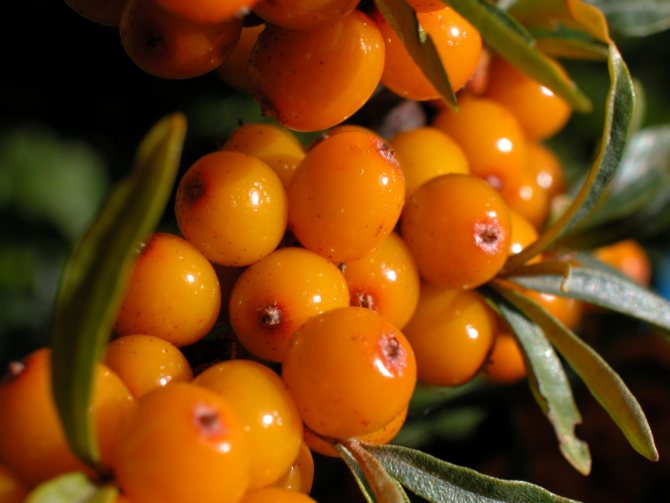

Sea buckthorn has long been used as a remedy for wound healing and strengthening the immune system.
In the 19th century in Russia, culture was mainly used for decorative purposes. For example, in those days, sea buckthorn bushes adorned the Tauride Garden in St. Petersburg. The Russian fabulist A. Krylov was also engaged in cultivation of shrubs - he even wrote a book in which he gave advice on caring for seedlings.
At the turn of the 19th and 20th centuries, sea buckthorn began to appear in many botanical gardens in Russia. Gradually, among gardeners, interest in it as a fruit crop increased; amateur gardeners in Siberia and the Urals began to grow it. In the XX century, sea buckthorn began to be cultivated in nurseries near Moscow and St. Petersburg.
I.V. Michurin, engaged in seed reproduction of sea buckthorn, noted the special value of Siberian seeds, from which the most hardy seedlings grew.
Since the early 1940s, when the composition of the fruit was studied, interest in the vitamin-rich sea buckthorn has revived again. Many scientific institutes began to develop new varieties with improved characteristics. Already in 1960, a group of scientists led by M.A.Lisavenko at the Altai experimental gardening station bred the first sea buckthorn seedlings of a new generation - these are well-known varieties:
- Gift of Katun;
- Altai news;
- A golden ear.
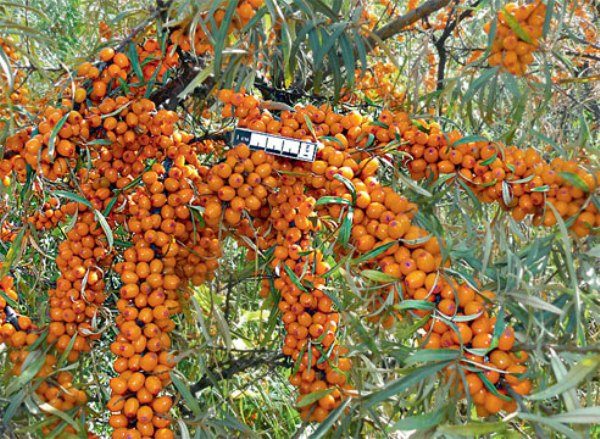

Sea buckthorn Golden ear belongs to the early ripening varieties and has a high winter hardiness
Many new Altai varieties are almost thornless, have large fruits with a high content of vitamins, sugar and oil.
Sea buckthorn planting and care. Pruning
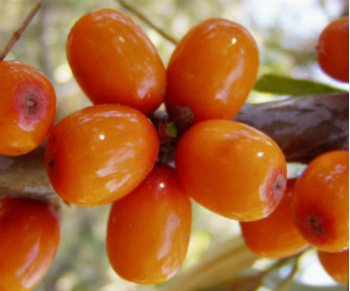

Planting sea buckthorn. The best time for planting sea buckthorn is spring (before bud break). It needs to be planted 3 × 2 or 2 × 2 m. One bucket of humus, as well as coarse river sand with gravel (on peat and clay soils) and 100 g of superphosphate, should be added to the planting pit. When planting, the root collar is deepened by 10-15 cm. After planting, the plants must be watered (15-20 liters per plant), then mulched with peat, humus or sawdust.
Care for young sea buckthorn consists in weeding, shallow loosening, watering.
Shaping and pruning. After planting, the seedlings are not shortened. In the future, only broken and dry twigs are removed. Pruning for three-five-seven-year-old wood showed that at the age of ten, the sea buckthorn still does not show signs of partial withering away of the bark of the main trunk, and under favorable weather conditions, shoots from dormant buds grow well. The older the wood is pruned, the less dormant buds remain, the fewer shoots grow and the less their total total growth.
With the help of rejuvenating trees that are not yet old, in the presence of a healthy trunk, strong shoots can be obtained from dormant buds, with the help of which to restore the crown in the future.
Harvesting. The most time consuming job is harvesting the sea buckthorn. Amateur gardeners pick berries using scissors with thin ends, as well as the simplest devices made of stainless wire with a diameter of 2-2.5 mm. To do this, a clean plastic wrap is spread under the bush and with a springy hook of a wire device they cover the branch on both sides at the base of the one-year growth and shedding of the berry.
Clean berries from the film are poured into enamel buckets together with juice. It is impossible to be late with harvesting, as the birds bring big losses.
Processing of berries. Recently, this culture has been very popular among amateur gardeners.Its fruits contain carotene (2-10 mg), vitamins C (50-180 mg), E (tocopherol), K1 (phytoquinone, 0.9-1.2 mg), P (75-100 mg), in small amounts of B1 (thiamine), B2 (riboflavin), B9 (folic acid), as well as trace elements - iron, boron, manganese, up to 9% sugar, 3% organic acids. The berries contain up to 9% of sea buckthorn oil containing unsaturated fatty acids (linoleic, linolenic).
Fruit can be used to make compote, jam, juice, jelly.
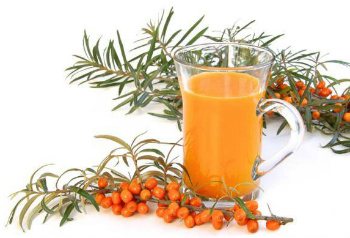

Compote. The fruits are washed, sorted, placed in jars, poured with syrup (400 g of sugar per 1 liter of water) and pasteurized at 80 ° half-liter jars 10, liter - 15, and in boiling water, respectively 8 and 10 minutes.
Spring pruning
At the end of winter, branches are cut, rather, for sanitary purposes. Do this before the start of sap flow. For those who have experience with raspberries, the process will not cause any particular difficulties. First, the bush is freed from frozen twigs in winter, heavily sagging. If after the operation the crown seems too thick, you can remove some of the strong ones that thicken the bush.
In young bushes, formative pruning is carried out at the same time.
It is only necessary to remember that the branches that have borne fruit last year should not be removed from the sea buckthorn. Unlike raspberries, they are not considered old yet.
Rejuvenate sea buckthorn trees or shrubs approximately at 6-7 years of age... Branches that have stopped growing, give a poor harvest, are removed. At a time, in order not to harm the plant, from 1 to 3 are removed, leaving in return young strong shoots, even tops. The plant is rejuvenated in stages, after 3 years it will look like new.
For novice summer residents, there is a diagram below that will help to properly cut the sea buckthorn.
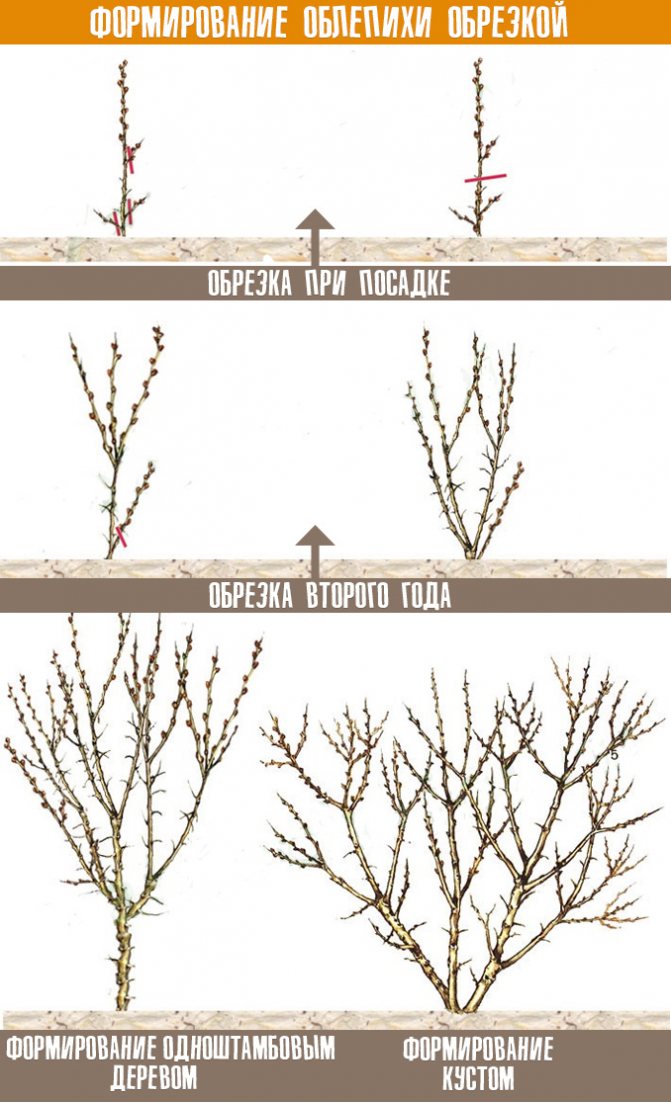

If the tree, unfortunately, breaks down or does not survive the winter well, everything is cut off to the root collar. A strong root will drive out a new one from the growth, from which in 3 years it will already be possible to harvest.
Powerful shoots, which are 8-10 years old, are removed with a hacksaw, the younger ones - with a pruner. Along the way, they examine the plant for diseases and pests.
Advice. The trunk should be closely monitored during fruiting. If there are branches where slightly faded berries are visible, which fall off prematurely, this indicates the presence of endomycosis. So that the disease does not spread to the entire plant, does not destroy it, you need to mercilessly remove and burn such growth.
Sea buckthorn in the open field - all about planting, care and reproduction
Caring for sea buckthorn, according to many gardeners, is a thankless task. There are too many berries from it, then there are almost no, thorns stick out in all directions, and the taste leaves much to be desired. It turns out that all these unsightly descriptions relate only to the wild sea buckthorn.
It was she who was grown in the USSR, it is she who still flaunts at the "grandmother's" dachas, and it is with her that we have all the most unpleasant and "prickly" memories. Needless to say, berry bushes of modern varieties have a very distant resemblance to their wild predecessor. True, in order to get an excellent harvest, it is no longer enough just to stick a branch cut from a neighbor into the ground. Sea buckthorn, although not capricious, requires certain agrotechnical knowledge and skills from the gardener.
Why is it difficult to harvest sea buckthorn?
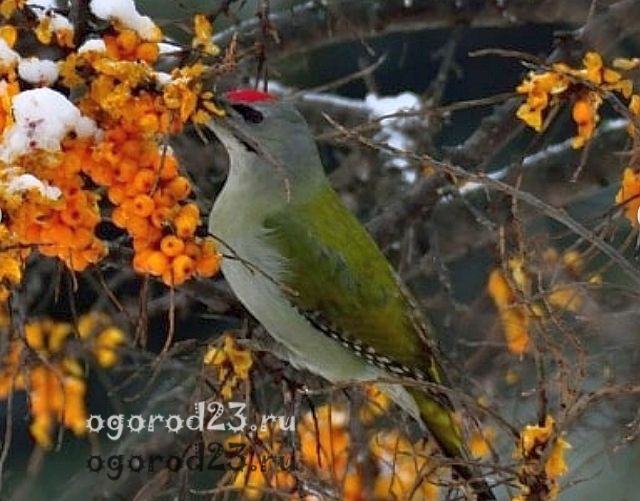

Green woodpecker on sea buckthorn
This task is quite difficult, the process can be traumatic due to the sharp thorns that cover the branches. Sea buckthorn has rather short stalks, and ripe berries are soft to the touch, easily wrinkled under the fingers. Plus, the juice of the fruit is very acidic and can irritate the skin of the hands with prolonged contact. What to do in this case?
There are radical methods in which the branches are pruned along with the fruits, but this is quite cruel in relation to the tree. Experienced gardeners have found a way out of this situation. To begin with, before harvesting, put on those clothes that you will not mind getting dirty, and this will inevitably happen.The second rule - you need to collect fruits from the top of the branch towards the bottom.
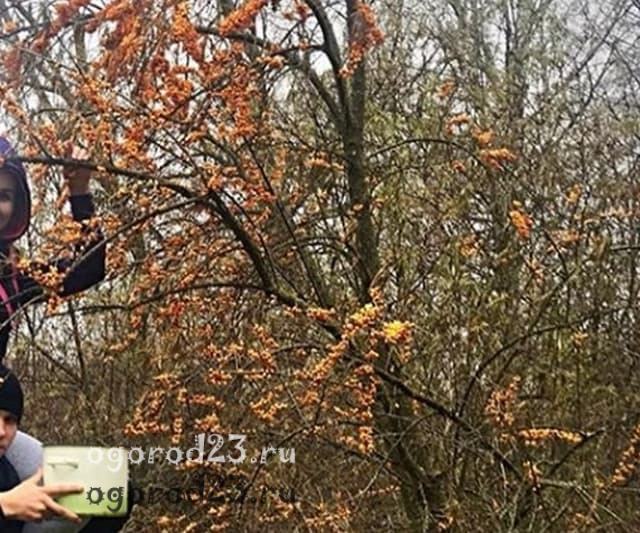

How to collect sea buckthorn:
- The first method is a rough one, in which branches with fruits are carefully cut off and immediately frozen. Frozen berries can be easily removed from the branches, but this method is only suitable for those cases when you need them frozen.
- The second method is manual; cherries, cherries, apricots and other fruits are harvested in the same way. It is traumatic, takes a long time, and requires increased attention.
- The third method is “skillful hands”, ie. the manufacture of auxiliary devices. Gardeners go to various tricks: a sharp scraper is attached to a long stick with electrical tape, which, as it were, is used to comb the berries from the branches. Your helper should stand at the bottom and hold either an open bag or an open umbrella for picking berries. Sometimes a long-handled knife is used and the fruit is harvested in the same way. However, the most convenient device is considered to be "cobra" - this is a popular name that has taken root among gardeners and summer residents. The device is a loop of dense wire that is securely attached to a long handle. You can drill two holes at the end of a rounded stick and thread a wire through them. For convenience, the loop itself is slightly bent so that, when viewed from the side, it resembles a cobra's hood. The top of the loop should be slightly narrowed. The attachment point must be securely wrapped with wire or wrapped several times with insulating tape. Now you can quite conveniently cut the stalks with a "cobra", you can open the umbrella from below, where the berries will fall.
The method of collecting sea buckthorn "cobra" is the most acceptable, less traumatic.
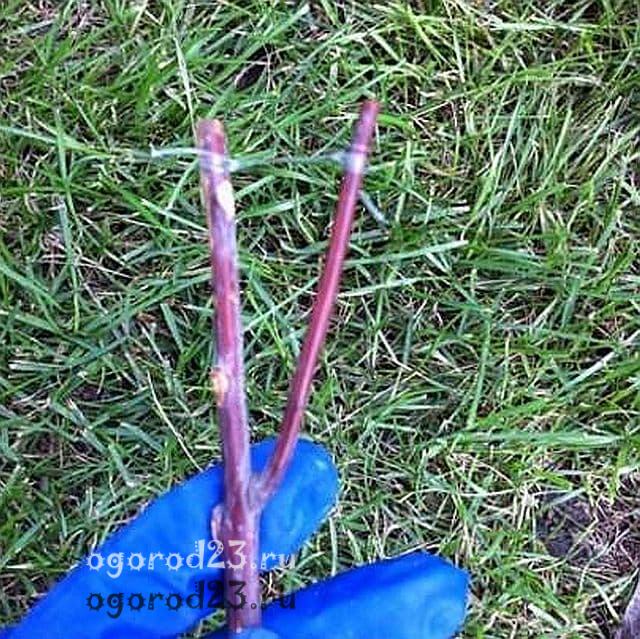

A device for collecting sea buckthorn berries - a thin nylon rope is stretched between the slingshots
You can also wait for the first frost, spread a cloth or a piece of polyethylene under the tree, then arm yourself with a heavy stick and attack the trunk with branches with it. Frozen fruits will separate from the branches from the blows and fall on the prepared blanket. Decide for yourself - how it will be more convenient for you.
Watch a few videos, maybe you will use ideas, picking berries with devices that are easy to do yourself, with your own hands.
Sea buckthorn species
There are only two types of sea buckthorn in the world, but there are countless varieties. In the mountains of Nepal, some provinces of China, as well as Bhutan and India, willow buckthorn is found, and in the territory of other countries, buckthorn is common - we grow it exactly.
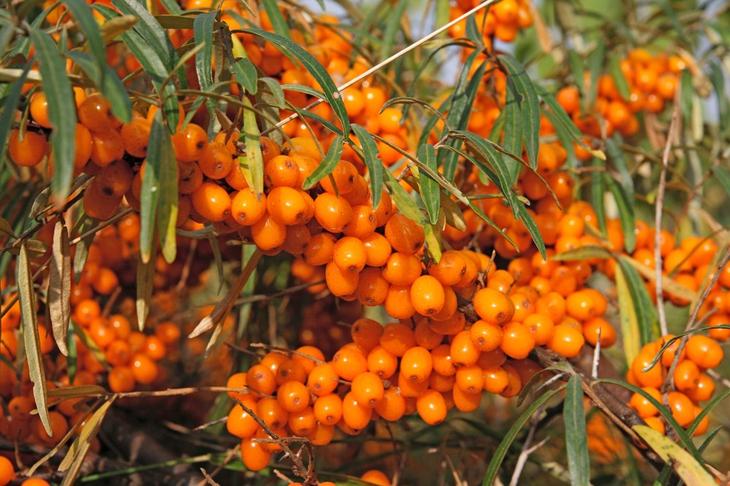

It is not difficult to distinguish a bush, once you see it, you will never forget what a sea buckthorn looks like. Its thin, grayish leaves, nondescript flowers and numerous thorns, of course, cannot be considered beautiful, but branches strewn with golden fruits can become the pride of any garden.
Why sea buckthorn is useful
The yellow, oblong berries contain several times more carotene than the carrots and pumpkin touted by doctors. Therefore, nutritionists and cosmetologists love sea buckthorn so much.
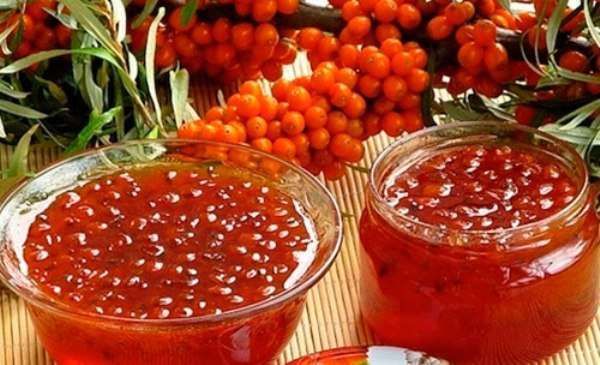

It is used in the manufacture of many medicinal preparations, as it has analgesic and antiseptic properties. And vitamins and healthy oils make it an ideal ingredient for anti-aging and nourishing creams, lotions and masks.
Home doctor: the beneficial properties of sea buckthorn
Sea buckthorn male and female - learning to distinguish
Repeatedly, there were cases when an inexperienced gardener planted the coveted bush, watered, pruned and could not understand why the sea buckthorn did not bear fruit. But everything is extremely simple: sea buckthorn is a dioecious plant, that is, there are "male" and "female" trees. The former are needed only for pollination, and there are no berries on them, and the latter, capable of producing crops, simply do not pollinate without a “man” growing in the neighborhood and will not tie anything.
That is why it is necessary to plant at least one "male" plant on the site. By the way, it can be wild, this will not affect the quality of the berries.
The easiest way to distinguish "male" sea buckthorn from "female" is in spring, when neither leaves nor flowers have blossomed yet. This should be done for the kidneys. "Male" plants have large buds with 5-7 scales, while "female" buds are half as small and have only two covering scales.
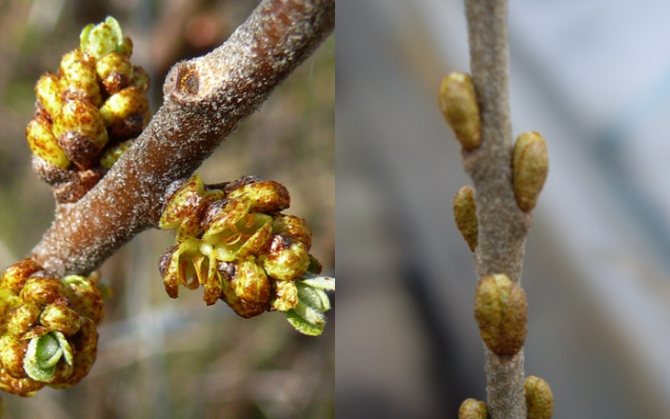

On the left in the photo is the buds of the male sea buckthorn bush, on the right - the female
Harvesting cuttings in the fall
In order to carry out the rooting of lignified sea buckthorn cuttings in the spring, from the end of November to the beginning of December, you need to properly prepare the raw materials. To do this, you need to select 2-year increments, the thickness of which is at least 6 cm. They need to be cut with a sharp tool into segments 15-20 cm long.
Cuttings cut in the fall should be prepared as follows:
- Tie into a bundle.
- Wrap in cloth and put in a plastic bag.
- Bury the bag in the hole.
- Throw snow at the hole. If it has not fallen out yet, you can cover it with spruce branches or dry leaves.
Cuttings saved in this way are required to be kept in water for 3 days before planting, which should be changed several times. It is advisable to add a root formation stimulant to it. After soaking, the cuttings can be planted in the ground at an angle, leaving at least 2-3 buds above the surface. By the fall, the stalk will stretch up to 60 cm in height, and in the third year it will begin to bear fruit.
How to plant sea buckthorn in different seasons
The genetic memory of the "sea thorn" (this is what sea buckthorn is called in warm countries for its love for the shores of water bodies) is quite strong, and the shrub often starts growing during the first thaw. Alas, we are far from the Mediterranean climate, and therefore sea buckthorn that awakened too early can freeze and die.
When planting sea buckthorn in autumn, carefully cover the seedlings, mulch their roots and root collar. Plant a few plants just in case, because there is a high probability that not everyone will survive the winter.
Therefore, in our latitudes, it is more correct to plant sea buckthorn in the spring, when the frost has already passed. The branched root network of the sea buckthorn will not allow you to transplant the plant without loss, so you need to choose a permanent place for the seedling right away. The main requirements of the culture are illumination and neutral soil.
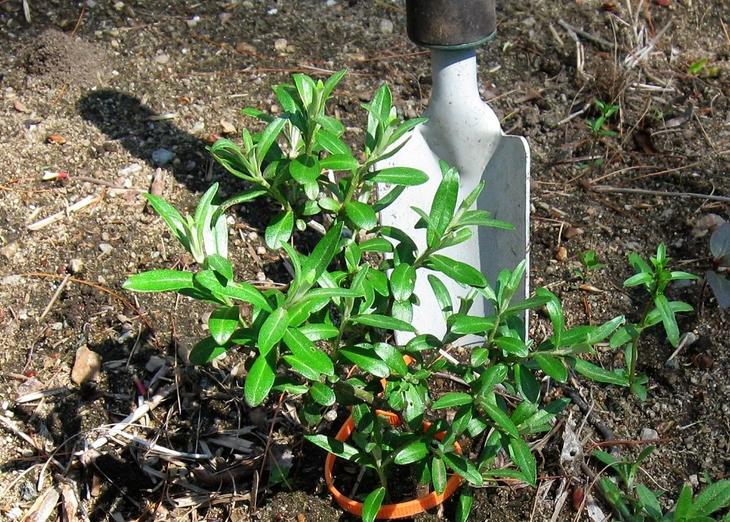

In order to properly plant sea buckthorn, no special knowledge is required:
- seedlings are planted at a distance of 2.5-3 m from each other;
- "Male" plants are planted upwind;
- if the neighbors have a "male" sea buckthorn, then you can do only with "female" plants, provided that the distance to the neighbor's pollinator is no more than 10 m;
- the diameter and depth of the planting pit is about 50 cm;
- humus, double superphosphate (according to the instructions) and a handful of ash are introduced into the pit;
- the root collar of the seedling is placed at the soil level;
- after planting, the plant is abundantly watered and mulched with cut grass, dry soil or low-lying (black) peat.
Landing nuances depending on the region
In Siberia and the Urals the soils are heavy, so sand must be added when planting. A place is chosen where there is less snow layer, since tree branches are fragile and can break under the weight of snow. Young plants planted in the fall require shelter. In spring they are planted from April to May.
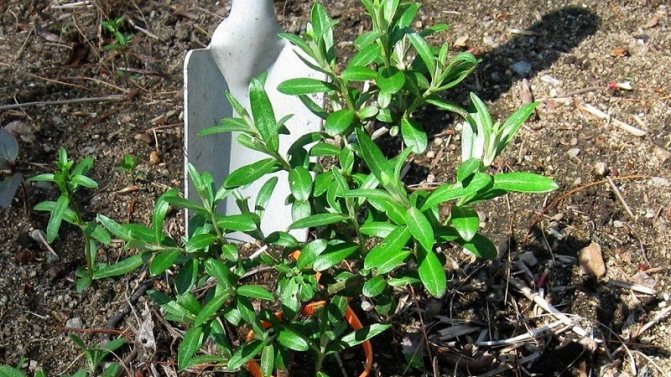

In the Volga region it is recommended to plant only zoned varieties. Winter is mild, but long. The planting date is the first days of March.
In outskirts of Moscow the climate is suitable for growing sea buckthorn, it does not need shelter. Planting is carried out from the end of March to the first half of April.
Reproduction of sea buckthorn
The easiest way to buy a sea buckthorn seedling is in a nursery - now there are many varieties on the market with multi-colored sweet berries and even soft thorns. If you are not looking for easy ways, try growing sea buckthorn from seeds, cuttings or shoots.
Sea buckthorn from seeds
Reproduction of sea buckthorn by seeds is a long, unprofitable and interesting process for altruists and botanists.It will take at least 6 years from planting the seed to harvesting, and the result will hardly impress you. Traits of cultivated varieties, therefore, are almost never inherited, and you can get wild in a more affordable way.
Where does sea buckthorn grow
In the wild, it grows on rocky and sandy soils, in river valleys, near streams, reservoirs, on the seashore. Because of this, it is often called sea thorn, sandy berry, dune thorn. The homeland of sea buckthorn is the highlands of the Himalayas. Where does sea buckthorn grow in Russia? You can answer - everywhere, except perhaps in the regions of the Far North. Today this culture is spread all over the world. This is a representative of the sucker family. Through the efforts of breeders, many of its varieties have been bred.
Where and how sea buckthorn grows in the wild, photo:
Sea buckthorn care
Sea buckthorn is not capricious, it is little susceptible to diseases and almost does not need care. It can be considered a true gardener's dream, at least until the moment of berry picking.
How to feed sea buckthorn
Sea buckthorn roots are stretched with such a wide network that traditional feeding in the near-stem circle of an adult plant makes no sense. But cuttings and young plants should be "treated" with potassium-phosphorus mixtures and watered more often - this will allow them to grow up sooner.
How to prune sea buckthorn
Formative pruning of sea buckthorn is carried out in early spring before the buds bloom. The first 4-5 years after planting a tree, all improperly growing shoots are removed so that the crown does not thicken and form evenly. After the sea buckthorn turns 8 years old, rejuvenating pruning is used. Only 1-3-year-old shoots are left for fruiting, and all the older ones are mercilessly removed. Well, the pruning of sea buckthorn in the fall is more of a sanitary nature - during it, patients affected by lichen or broken branches and shoots are removed.
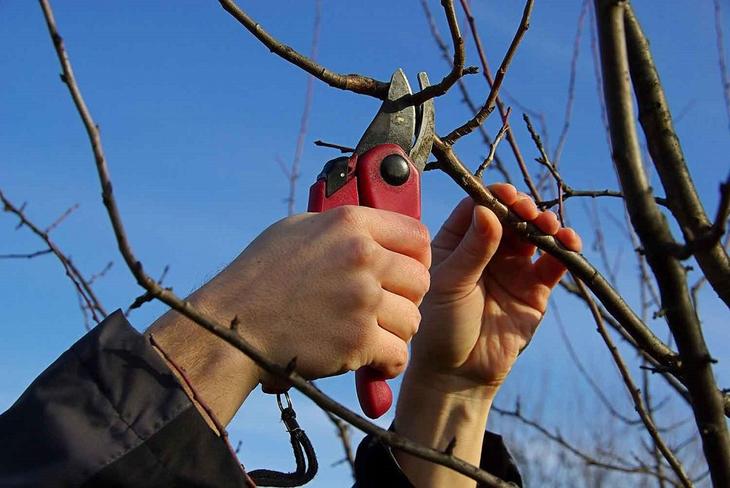

When to transplant sea buckthorn
The branched root system of sea buckthorn makes the transplant of this plant almost impossible. No matter how hard you try, some of the roots will be damaged during digging, and sea buckthorn may not take root in a new place. Therefore, if you are not sure about choosing a place for this plant, transplant the sea buckthorn as soon as possible, preferably in the first 2-3 years of the plant's life.
Why prune sea buckthorn
Pruning sea buckthorn involves removing a certain number of shoots, and there may be several reasons for this:
- support of plant health by timely cutting off diseased and pest-affected branches;
- increasing the decorativeness of culture;
- increasing or maintaining a consistently high yield;
- an increase in the life of sea buckthorn trees or shrubs.
Of course, depending on the specific purpose of the procedure, its type, with all its features, will also depend.
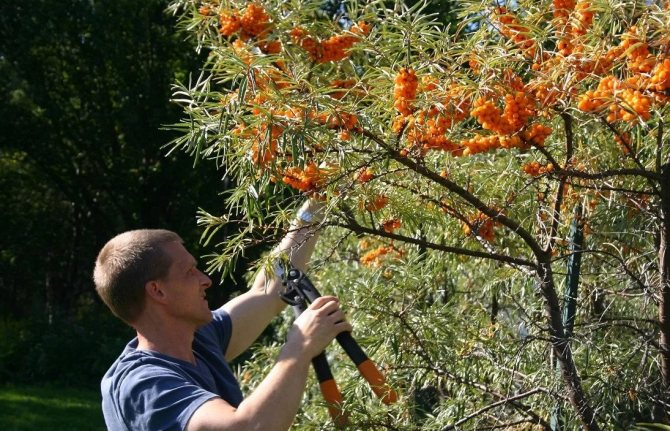

Harvesting sea buckthorn
Berries on thorny branches begin to turn yellow quite early, and a natural question arises - when to pick sea buckthorn. It depends on the variety and on the region of your residence. As a rule, from August to September, the berries are already juicy, but still quite firm and are only suitable for jam or freezing. And from the end of September to October, they become more mature, with a soft skin and are suitable for making butter, jam or marmalade.
Hand picking berries
The debate about how to properly harvest sea buckthorn has not subsided for decades. On the one hand, manual picking is more humane in relation to the plant, because it does not harm the branches and buds. But the person himself is forced to suffer a lot when collecting sea buckthorn. In addition to thorns that can pierce even thick gloves, the juice of this berry corrodes the skin. Therefore, for "prey" you need to go out in clothes with long sleeves, an apron and rubberized gloves. This will protect you, but will reduce your maneuverability and prevent you from quickly picking up the sea buckthorn from the tree.
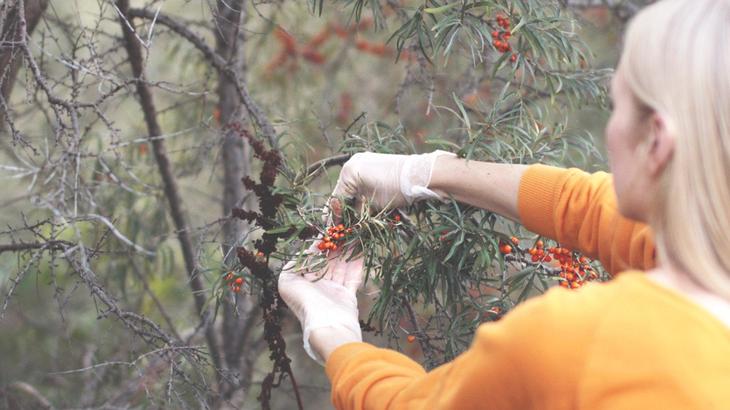

Tools and materials
The specific type of tool for trimming sea buckthorn should be selected taking into account the type of procedure being performed. For example, for cutting large stem specimens or removing branches of a large diameter, it is best to use a fine-toothed hacksaw, ordinary thin shoots are often pruned with a lopper, and a small garden knife is quite suitable for removing the smallest branches themselves.
Alternatively, you can prepare two types of pruners at once: one small, and the second a little larger, but always with well-sharpened blades and sharp ends. For thicker branches, it is better to use cutting tools with long handles, so the cutting process requires less physical effort.
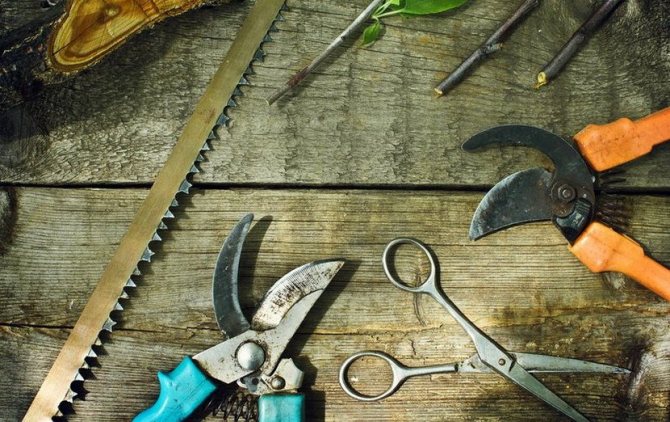

Before performing the procedure, all the blades of the instruments should be treated with a solution of copper sulfate, which will prevent the development of fungal infections. It can also be added to the mixture to seal wounds formed on the tree, which, despite the quick drying of the sea buckthorn juice in the open air, will serve as additional protection against infection. After trimming is complete, all used equipment should be disinfected, dried again and only then put into storage.
What should be the planting material?
Features of growing sea buckthorn are determined by its biology. It is a dioecious wind-pollinated plant. For the fruiting of the female plant, the close position of the male plant is required. Popular male varieties are Alei and Gnome.
When buying planting material, you need to choose only seedlings obtained from cuttings (they, as a rule, have a well-developed root system and a short shoot). From seedlings grown from seeds, a thorny wild will turn out, and the acquisition of dug out shoots (with a long growth) is akin to playing Russian roulette: there is no guarantee that it will be a female fruiting plant, since it is impossible to distinguish it from a male one in this case.
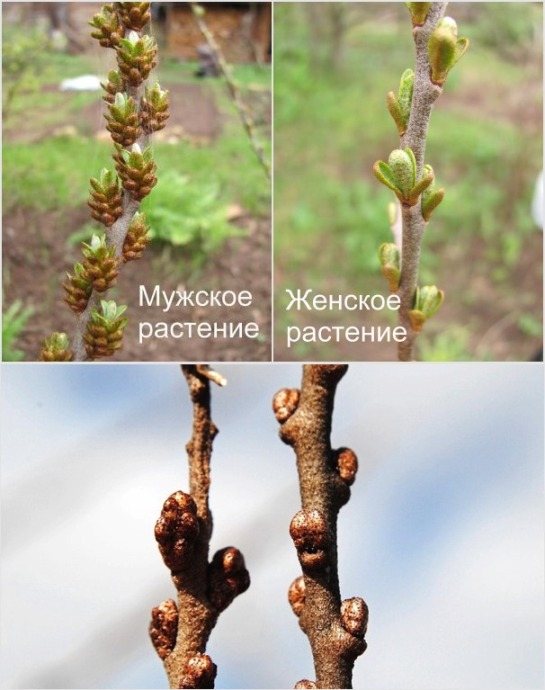

You can determine the sex of a young seedling by the following criteria:
- if the buds are large with 5 - 7 scales, then there is a male plant in front of you;
- if the buds are elongated and small with 2 scales, then it is a female plant.
This rule is true both in the spring before the blooming of flower buds and in the fall after the shedding of leaves.
In sea buckthorn, nodules form on the roots, which help the plant to absorb atmospheric nitrogen. Do not mistake this symbiosis for painful growths and break off or cut them off.
If space in the country is sorely lacking, then you can graft several cuttings from the male plant onto the female plant, thus artificially obtaining a monoecious plant.
Features of planting sea buckthorn
A shrub with fragile roots is planted immediately in a permanent place. Experienced gardeners recommend paying attention to some of the features of planting a plant:
- Tubers-outgrowths may be present on the roots. They are crop-specific and are designed for better nitrogen absorption. They are not removed during planting.
- The root system of an adult sea buckthorn is spreading, reaching several meters in diameter, regardless of the crown. It is located high to the soil surface, at a depth of 30-40 cm, so there should be no trees nearby.
- It is convenient to plant a shrub near the fence, at the edge of the site.
- A male bush is planted in the center in a group of female ones. If the row of trees is male on the leeward side, then female.
The root collar during planting is not below ground level.
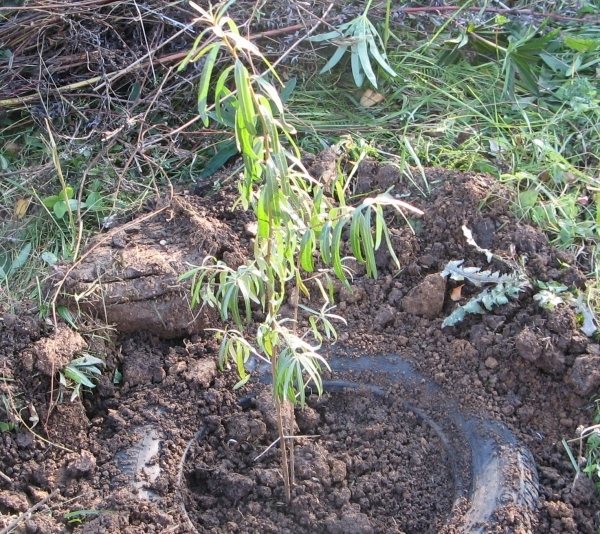

Basic rules for autumn and spring planting of a bush in the country
Many budding gardeners believe that there is no difference. between spring and autumn planting and sea buckthorn transplant. But it is worth remembering that these two procedures have significant differences, which lie in the following features and rules for seasonal planting.
For spring work adhere to the following recommendations:
- Planting of plants is carried out before the onset of hot weather, so do not rely on a predetermined framework. The gardener must carefully monitor the air temperature in the region and choose the most favorable period.
- When planting, organic fertilizers are used, for example, manure.
- Immediately after planting, young plants need careful care, which consists in timely watering and protection from the scorching sun.
- To accelerate the growth of sea buckthorn, as well as the appearance of young shoots, various growth activators can be used.
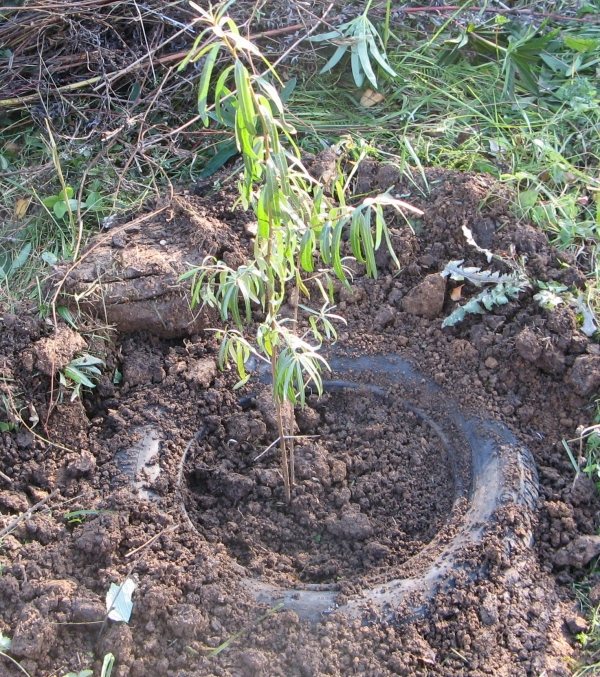

There are significant differences and rules between the spring and autumn plantings of sea buckthorn that must be adhered to.
During autumn works adhere to the following rules:
- Particular attention should be paid to checking the condition of the root system of the seedling. Diseased plants most likely will not be able to take root in a new place.
- If the planting dates have been missed and the cold has come, then the sea buckthorn is added dropwise before the onset of spring.
- During this period, manure cannot be used as fertilizer, as it can damage the roots of the plant.
- In order for the tree to survive the winter, it must be carefully covered using various improvised means, such as spruce branches, paper, film, blankets, snow, etc.
- For protection from the wind, sea buckthorn is tied to a peg, which will serve as support and protection.
Which seedling to buy
Requirements for the purchased seedling:
- In the presence of at least three skeletal roots up to 20 cm and a large number of small root processes;
- A trunk with a minimum height of 35 cm, a maximum of 50 cm, a trunk diameter of at least 6 cm;
- The presence of shoots on the trunk;
- Elasticity of the bark without damage or wrinkling;
- The bark does not flake off, and the wood under the bark does not have a brown tint (if it does, it means that the plant is frostbitten).
- The fewer thorns on the sea buckthorn, the better the variety. The absence of thorns is also a plus.
- It is enough to have 4 female sea buckthorns and one male pollinator on the site, so that the sea buckthorn is enough for five people for the whole year.
- If there is already a male in the neighboring garden and there are less than 10-12 meters between the plants, it is enough to plant only a female plant.
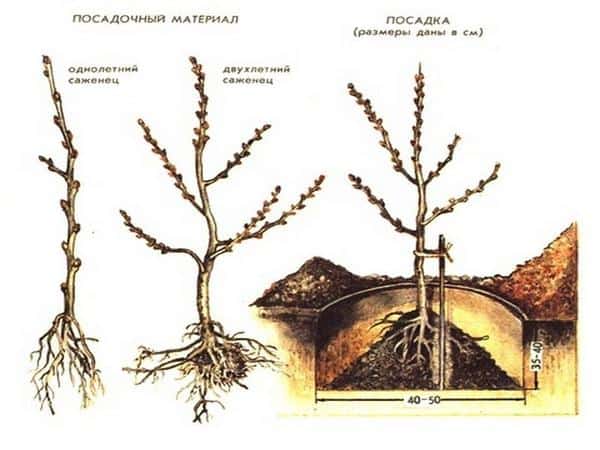

general characteristics
Studying the question of how to plant sea buckthorn, first of all, you need to familiarize yourself with the main features of this plant. It lives in nature on the shores of seas and rivers. Sea buckthorn belongs to the Lokhovy family. Both undersized and tall varieties are cultivated. Their leaves are gray-gray in color. They are thin and sharp. Flowering occurs before leaves appear. This process is not highly decorative. It may even seem that these are not flowers, but small leaves.
Most often, gardeners grow buckthorn buckthorn. It is widespread throughout the world. The willow buckthorn is also cultivated. In nature, this species grows in the mountains of Nepal, India and southern China.
Sea buckthorn is considered a frost-resistant tree. How to plant and grow a plant depends on the conditions of the climatic zone. If there are sudden changes in temperature during the cold period, the tree may freeze a little. This is especially noticeable on the rudiments of male inflorescences. Productivity is directly dependent on environmental conditions. Fruiting occurs in the 4th year of the tree's growth.
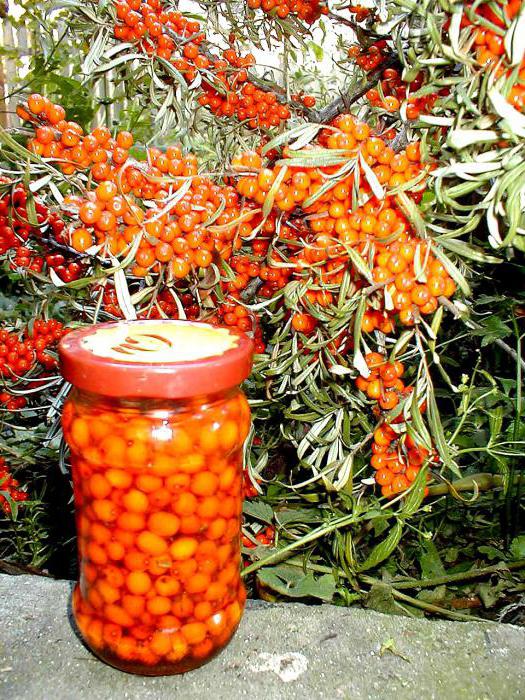

Sea buckthorn loves sunlight. If it is not enough, seedlings develop poorly. During the fruiting period, sunlight stimulates high yields. The berries have a sweet and sour taste. In garden species, the fruits are medium to large in size. They can be orange, reddish, or yellow-orange. Berries are eaten raw, preserved, added to various dishes. They are used for making cosmetics and medicines. Sea buckthorn oil is especially appreciated. It is prescribed in a complex for the treatment of various ailments. The fruits enrich the body with vitamins and minerals.
Weed control
Weeds are harvested regularly, especially in the early days after planting. Not getting enough light and nourishment, a tree overgrown with weeds can die. Combine weeding with loosening.You can reduce the amount of weeding by covering the trunk circle with dark plastic wrap. Remove it from time to time to control moisture stagnation.
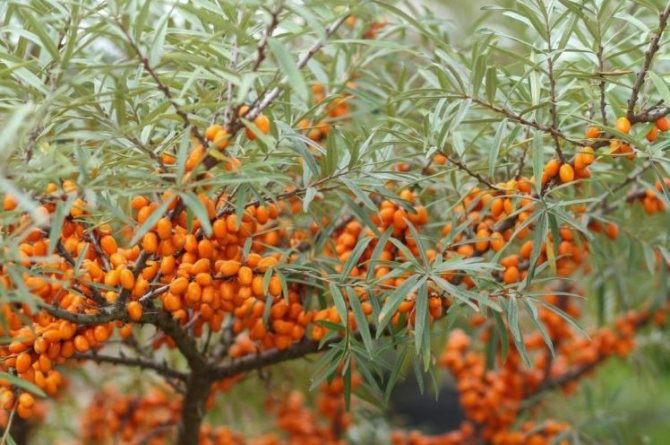

Recommendations for choosing a seedling
Considering where to plant sea buckthorn on the site, you need to pay attention to the choice of its seedlings. The quality of the crop, its abundance will depend on this. Experienced gardeners do not recommend purchasing seedlings from unfamiliar sellers. In this case, it cannot be guaranteed that a pure plant variety will be planted on the site.
It is best to purchase biennial plants for transplanting. They have 3 to 5 main roots. Their length should be about 20 cm. There should also be a sufficient number of small, secondary roots. The trunk of a biennial sea buckthorn usually reaches 35-50 cm. Its diameter is approximately 7 mm. Several shoots depart from the trunk.
The bark should not flake off. It is elastic, free from defects and scratches. If the wood has a brown tint, this indicates freezing of the plant. They are not worth purchasing. Such seedlings practically do not take root.
Possible landing errors
Due to poor knowledge of the characteristics of sea buckthorn, novice gardeners often make mistakes, which become the causes of diseases and death of young seedlings. To save a young plant from the consequences of your own wrong actions, it is better to first familiarize yourself with their main content:
- Trees of the same sex are planted on the plot.
- Nodules are cut off at the roots, mistaking them for unnecessary growths.
- When caring for young plants, they loosen the soil too deeply.
Thus, it is very easy to plant and grow sea buckthorn if all the above recommendations are followed exactly.
Video: spring planting sea buckthorn
How to fertilize
Sea buckthorn is not harmful in terms of fertilization. Due to the wide root system, it independently finds nutrients in the soil and there is no need to fertilize it for the first years.
Read also: How to put yeast dough on water
If desired, for better formation of new shoots of the plant in the spring, you can fertilize sea buckthorn with urea (up to 30 g per 1 bucket of water). Each tree or bush is watered with half a bucket of liquid.
It is advisable to fertilize young growth with organic fertilizers. For example, stir humus in water and water the plant around. This procedure should be carried out once every three years.
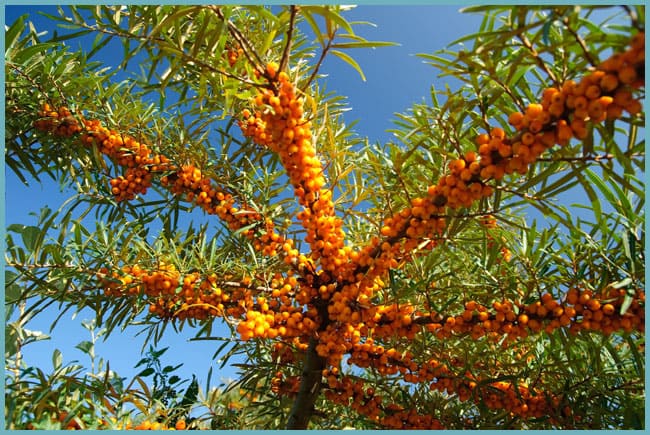

Sea buckthorn loves moisture, so it is worth watering it infrequently, but with plenty of water. Paying such attention to the plant, sea buckthorn will bring a good fruitful harvest every year and will not interfere with other plants with its roots. Get treated, enjoy the beauty of this plant and do not forget the peculiarities of caring for it!
Planting and caring for sea buckthorn is easy. Even a novice gardener will not find it difficult to get a good harvest of berries, subject to certain rules. This article describes the principles of growing sea buckthorn, agricultural techniques and methods of working with this shrub. Its main diseases and pests are listed, as well as recommendations on preventive and control measures are given.
Propagation by woody cuttings
Considering how to plant sea buckthorn in spring, another interesting way should be considered. Wood cuttings are also capable of taking root. They are prepared in autumn or winter. For this, several shoots are cut, the thickness of which exceeds 5 mm. So that they do not begin to develop ahead of time, seedling material is dropped in the snow.
In the spring, you can start the process of breeding sea buckthorn. Sections about 15 cm long are made from the blanks. They are kept in water for several days. If you leave the blanks here for 2 weeks, small roots will appear, buds will begin to form.
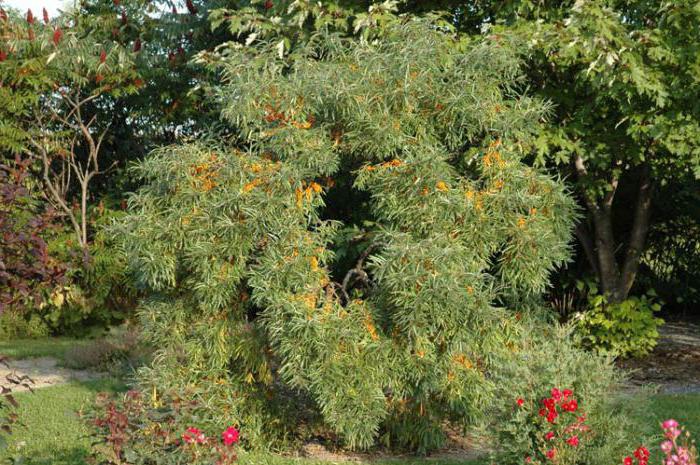

The cuttings must be planted in fertile soil. They are deepened by about 15 cm. A shoot with 2 buds should remain above the ground. The cuttings are grown in greenhouse conditions. The air temperature should be around 27 ° C.High humidity levels are maintained. When the plant is 50 cm in height, it is planted in open ground. Where to plant sea buckthorn on the site should be determined with the recommendations listed earlier.
It is necessary to plant cuttings at a distance of 10 cm from each other. The soil is well compacted and watered abundantly. By autumn, the roots of the plant will be able to strengthen and develop sufficiently. The plant will be able to overwinter.
Sea buckthorn transplant
Sea buckthorn does not respond well to transplanting, so this procedure should be taken extremely responsibly - the re-operation the hive may not tolerate. So the choice of a site for a plant should be approached thoroughly, with the expectation that it will grow there constantly.
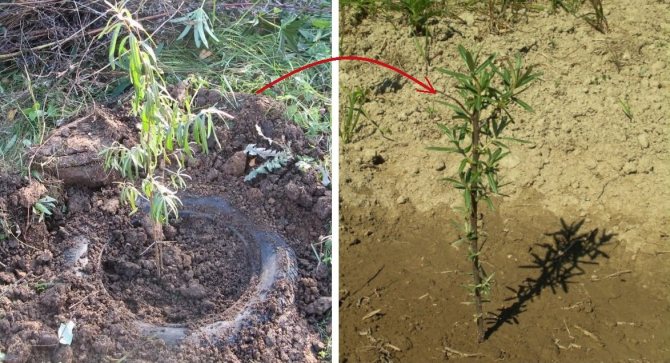

When transplanting to a new place, some cultural features should be taken into account:
- sea buckthorn is a dioecious plant, if you want to get a harvest, you need to plant males and females;
- one male bush is capable of fertilizing up to 5 females, so there is no need to grow an equal number of plants of both sexes;
- take into account the direction of the wind in the place of cultivation of sea buckthorn, this circumstance is important, since the plant is pollinated with its help.
Did you know? After the explosion at the Chernobyl nuclear power plant, the first means that were used to treat the victims were the cinquefoil root and sea buckthorn.
It is possible to distinguish bushes by gender only for 4-5 seasons, after the first flower buds begin to form.
Signs that will help establish the sex of the plant:
- the kidneys of females are smaller, males are collected in inflorescences, similar to an ear;
- the leaves of the male bushes are flat, and the female ones are curved, cup-shaped;
- at the end of spring, the crown of males is silvery, in females it is bright green;
- flowers of female plants are yellowish, of male plants are silvery with a greenish tint.
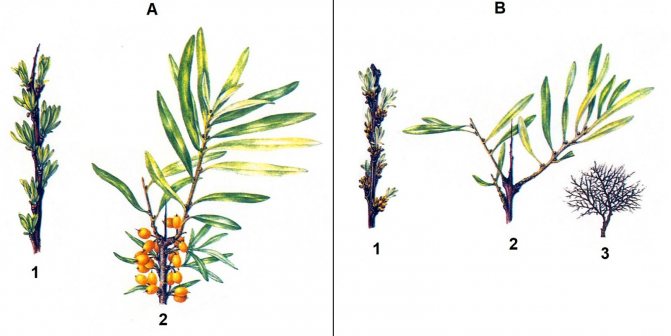

A - shoots of a female plant: 1 - female inflorescences and young shoots of continuation; 2 - shoots with fruits in the axils of the upper kidney scales. B - shoots of a male plant: 1 - spike-shaped inflorescences of male flowers; 2 - growth of the current year; 3 - adult plant (5 years old).
Adult plant
Clay soil with poor moisture conductivity is not suitable for planting shrubs. If this is exactly your case, dig up the ground, adding 2 buckets of sand for each square meter. It's best to do this in the fall, so you don't have to do this in the spring before the snow has melted.
In addition, when digging a garden, the area where sea buckthorn will be grown is fertilized with humus, compost and rotted manure, 1 bucket per 1 m². From mineral dressings make 8-10 tbsp. l. superphosphate and 1 tbsp. l. potassium sulfate to the same area.
Important! If you are replanting sea buckthorn without a root ball, do it very carefully so as not to damage the roots. Before planting, they are placed for 2-3 hours in a growth stimulator "Kornevin
»
, "Epin", "Heteroauxin", after which they are coated with a clay talker and then proceed according to the described scheme.
Pits should be dug, keeping a distance of 2–2.5 m between them. If you plan to plant in several rows, the distance between the adjacent ones is 2.5–3 m. The depth of the hole is 35–40 cm, the width is 50–55 cm.
The transplant itself looks like this:
- Lay a drainage layer (10–15 cm) at the bottom of the pit, consisting of a mixture of sand, expanded clay and broken brick.
- Prepare a substrate from equal parts of sod and leafy soil and humus. Mix the composition well and lay on the drain. The thickness of the soil layer should be such that the root collar of the bush installed on top is at ground level.
- If the bush you will be planting grows in your area, carefully remove it. To do this, within a radius of about 40 cm from the trunk, dig in the plant in a circle. Using the shovel as a lever, pry the bush up and out of the ground, taking care to keep the lump on the roots. Put the sea buckthorn in the wheelbarrow, take it to a new place and transfer it.
- You can take young shoots from a rooted unvaccinated plant and plant it. The bush must be carefully dug, the soil must be raked out with your hands and the root system must be examined in order to find out where the main mother root is located. Cut it off at a distance of 25-30 cm from the bush, and plant the plant in a new place.
- Place a seedling with a root lump of soil in a pit, cover it with the prepared substrate, tamp it slightly. Within a radius of 60–70 cm from the plant, build an earthen rampart 15–20 cm high. This will be a near-stem circle.
- Sprinkle each plant with 2 buckets of warm water. The soil in the circle is mulched with a mixture of peat and sawdust.
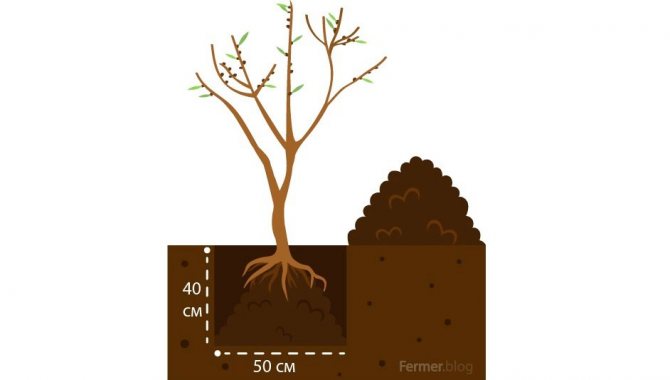

Young seedling
A young seedling, cutting, can be planted even at the beginning of summer.
They do it as follows:
- First of all, you should prepare a substrate from equal parts of humus, sand and peat. Mix all components thoroughly, place in a container with drainage (polystyrene, expanded clay and sand), spill with a solution of boiling water with potassium permanganate (1%). When all the excess moisture is gone and the soil is dry enough, you can proceed directly to planting.
- It is necessary to cut off a young shoot 14–16 cm long, remove 3 lower leaves from it.
- The part of the shoot, where the leaves were cut, clean, remove the bark and place in a solution of "Heteroauxin" or means "Epin".
- At first, the cutting is grown in conditions close to greenhouse conditions (air temperature + 26 ... + 28 ° С, humidity 85–90%). To create such conditions, a film is used, which must be periodically removed, gradually increasing the time.
- As soon as the first roots appear, the young sea buckthorn can be fed with mineral fertilizers.
- After 8-9 weeks of greenhouse cultivation, the film is removed permanently, and in early spring, young plants are planted in the ground as described above.
Find out if self-fertile sea buckthorn exists.
How to propagate sea buckthorn?
The process is carried out using cuttings, shoots and seeds. It is impractical to describe in detail the seed method, since this method takes too much time. The resulting plants do not inherit the varietal qualities of the mother tree, most often the result is "wild". Often, sea buckthorn is propagated by seeds in laboratory conditions to obtain new varieties, hybrids.
During coppice propagation, the young sea buckthorn inherits all the features of the main tree. Selected representatives are regularly watered in the spring and especially in the summer. With the arrival of a new spring, the shoot is carefully cut off with a small fragment of the root, after which it is planted in a separate place of residence.
How to propagate sea buckthorn by layering? It is necessary to select those branches that are closest to the ground. In the spring, near these branches, small depressions are made in the soil (about 10 cm). The branches are bent down and pinned to the ground with wire brackets. When these branches give shoots, the pinned place is covered with soil. The next year, again, with the arrival of spring, they are dug up, cut off with a pruner and transferred to a permanent residence or rearing.
The most high-quality and productive breeding method is the cuttings method. Cutting sea buckthorn is no different from cutting other fruit trees - everything happens in a similar way. Around the middle of summer, cut off a beautiful and strong stalk (about 15-20 cm in length), pinch off the three lower leaves, treat the cut with Kornevin (optional). Submerge the end of the cutting into nutrient soil, substrate, or moist vermiculite. A mixture of clean river sand, fertile soil and peat is perfect. Cover the top with a plastic transparent glass to make something like a greenhouse.
In the room where cuttings germinate, the air temperature should be approximately +26 .. + 28 ° С. Young livestock should be regularly watered, irrigated with a spray bottle, periodically ventilated (raise the glass).After about 8 weeks, the coating is removed, the stalk is fed with potassium-phosphorus additives. The cover is no longer used, the seedling is watered and waiting for a new spring, When it gets stronger, it is transferred to a permanent place of growth.
Sometimes on garden forums you can come across such a question - why doesn't sea buckthorn bear fruit? The answer is actually simple: sea buckthorn is a dioecious crop; to obtain fruits, the presence of male and female specimens is mandatory in the same area. If you have only "girls" growing up, then they will not bear fruit. "Boys" do not bear fruit at all, but are only pollinators. To solve the problem in the spring, you can plant a couple of shrubs of the opposite sex on the site. It is best to choose the cultivated male varieties "Alei" or "Gnome". Just in case, it is better to immediately plant two male trees, suddenly one will die or freeze in winter.
Vaccination also gives good results. You can take several branches from a healthy tree of the opposite sex (for example, from a neighbor in the country) and graft them on your sea buckthorn when spring comes.
If you need a transplant
If there is an urgent need to transplant the sea buckthorn to another place, then it is better to do this also in the spring, and while the tree is still small - 2-3 years old. An adult fruiting tree will not take root, since it is impossible to dig up all of its roots that have spread over the site. From a self-rooted sea buckthorn, unvaccinated, it is better to take the shoots and transplant it.
- Dig up the young plant carefully.
- Use your hands to rake the ground around to find out how the roots are located and to identify the main mother from them, coming from the tree.
- Cut off the main root at a distance of 20-30 cm from the seedling.
- Plant the young plant as shown above.
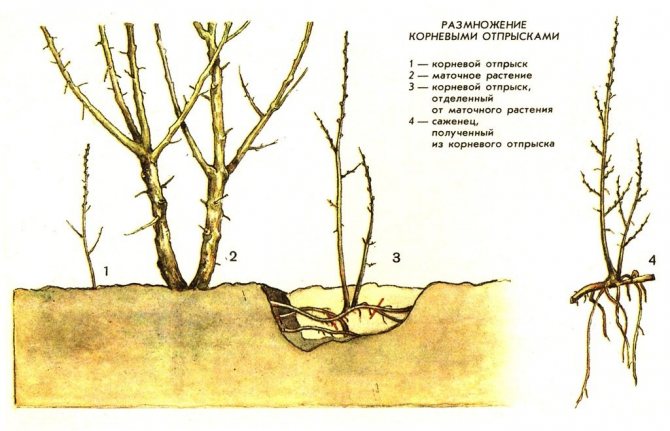

The shoots and the mother plant have a common root, which must be cut during transplantation.
In the same way, young trees are transplanted, raking the top layer of the earth in order to have an idea of the location of the roots. The less you damage them, the higher the chance that the sea buckthorn will take root. If the roots are damaged, then reduce the volume of the aboveground part: cut off the branches, shorten the trunks. It will be easier for the sea buckthorn to take root, and then it will quickly restore the crown.
The planting process itself is very simple, but there are many nuances when choosing seedlings and planning a site. Sea buckthorn is a dioecious plant, so one bush will bear fruit only if there is a male plant in the neighborhood, within a radius of up to 100 m. You also need to take into account the location of the roots: they spread horizontally and far from the tree, it will be impossible to dig the ground next to the sea buckthorn. So, before buying seedlings, you need to decide whether you have such a place in the garden and is it not a pity to allocate so much land for sea buckthorn.
Where to plant
A place. Sea buckthorn should be planted away from permanently cultivated soil. For example, a good location would be a corner on the edge of a vegetable garden, garden, lawn, near a road or building. This is due to the roots of the plant. They, like a net, develop and grow shallowly (15-35 cm from the surface), as a result of them it is easy to damage when digging up the earth. It should also be remembered that the roots grow several meters around the plant, they are easily injured, and this entails the weakening of the shrub or tree. As a result, the plant produces fewer fruits and may even die.
Another important factor for sea buckthorn is the availability of light. The plant does not like shady places, so you need to plant it in the sun. In a darkened area, it bears little fruit.
The soil
Sea buckthorn likes moist, light soils. On clay or acidic soil, it may not be accepted. To avoid this, the acidic soil is dug up together with ground limestone (approximately 300-450 g per square meter). First, lime is scattered over the surface of the earth, and then dug to a depth of 20-30 cm. When planting, lime is not poured into the pit so as not to burn the roots.It is advisable to do this procedure in the middle of autumn. This fertilizer is enough for 8-10 years.
The groundwater
They should be located at a depth of more than 1 m from the ground cover, since sea buckthorn does not like water stagnation.
Air
For better air penetration into the soil, you should fluff the ground near the sea buckthorn. The depth for fluffing should not exceed 10 cm, as there is a possibility of damaging the roots. On clay soils, so that air penetrates into the soil, it is recommended to mix the top layer of the earth with coarse river sand, adding humus in a one to one ratio. Optionally add up to 300 g of superphosphates and up to 50 g of potassium salt.
Wind
Sea buckthorn is a wind-pollinated crop, so males should be planted at the beginning of the row on the windy side. Or in the middle, where the female species surrounds in a circle. Sea buckthorn blooms from 7 to 12 days, so if the weather is calm outside, a branch with a flower is cut off from the "man" and shaken over the female flowers, pollinating them. How to tell the gender of a plant? In "men" the kidneys are half as large, have 4-7 scales, and in "women" the kidneys are longer, smaller, have only a couple of scales. For one male, 4-6 female seedlings are enough.
How to transplant: simple rules for transplanting a bush
The rules for transplanting sea buckthorn are not much different from the initial planting plants. The most preferable period is the spring period to transplant the plant, but autumn can also be suitable for this procedure.
In the spring, the tree will be able to quickly get used to the new environment and recover after the work carried out, while in the fall (especially in the Urals and Siberia) there is a risk of freezing of the sea buckthorn due to lack of time for survival.
Given the structural features of the root system of such a tree, many gardeners recommend not replanting an adult sea buckthorn at all, because there is a great risk of damaging its roots.
Despite the fact that sea buckthorn is one of the most useful berries, many gardeners grow such a tree or shrub for decorative purposes.
From this we can conclude that sea buckthorn not only bears fruit rich in chemical composition, but it is also a decoration of any site.
other methods
Sea buckthorn can be propagated on the site by root shoots. This is one of the easiest ways. Such shoots appear on the tree 4-5 years after planting. To take offspring for transplant, they must be separated from the mother plant with a shovel. Plants are planted in the ground and kept in greenhouse conditions. They are watered, maintain a sufficiently high temperature and humidity. Before planting, sea buckthorn must be tempered. They ventilate it, weaning it off the greenhouse climate.
Further, having decided where to plant sea buckthorn, the shoot is planted in watered soil. By the fall, it will develop strong roots. During this period, you can transplant the plant to a permanent place of growth. However, this procedure is still recommended in the spring.
If the grower wishes to speed up the formation of offspring on the mother tree, he can prune the skeletal root. He is at some distance from the plant. The incision must remain open. Many offspring are formed here. By the second year, they have a developed root system. In the spring, they can be transplanted into a hole prepared in advance.
You can also graft cuttings to sea buckthorn. This process is most often done when a male tree has died. Cuttings of the opposite sex are grafted into the crown of a female plant. Literally in a year, the branches are developing well and will be able to pollinate the inflorescences. This method is also used with a limited area of the site.
What are the best varieties to plant?
Sea buckthorn is widespread throughout Russia. In culture, it is grown everywhere, due to its high winter hardiness. The first cultural forms appeared in Siberia (Altai) - in the natural growing area.In the Altai Territory and Transbaikalia, sea buckthorn is also often found in gardens, like an apple tree in the Moscow region. Today, varieties have been bred that feel great not only in the Far East and Siberia, but also in the Urals and Central Russia.
Work on the breeding of varieties is going in the direction of increasing yields, eliminating thorny thorns on the branches, increasing the taste and increasing the size of the fruits. Forget grandmother's sea buckthorn with small sour berries on thorny twigs, which you don't even want to collect - modern varieties are devoid of these shortcomings. Of all the achievements of breeding, we note only the best varieties of sea buckthorn.
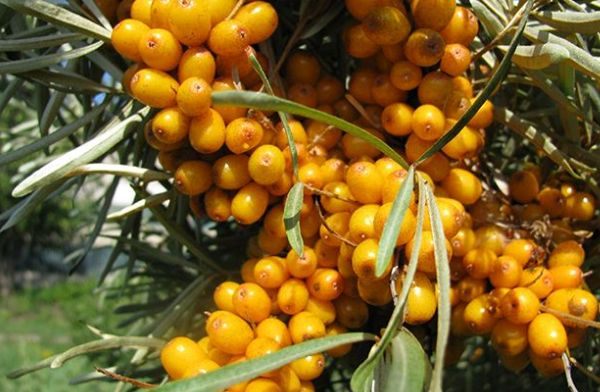

Chuiskaya
To begin with, let's note the varieties that meet all the basic needs of gardeners at once: they have a fairly high yield, fruits of dessert taste, compact bushes and are poorly covered with thorns or are completely devoid of them.
Naran - a variety of early ripening with large orange fruits of excellent taste and pleasant aroma; has a decent yield (up to 10 kg per bush); branches are poorly covered with thorns; bred for Central Russia.
Moscow beauty - variety of average ripening period; fruits of medium size, orange-red, with a slight sourness and faint aroma; dessert purpose; good portability; high yield (up to 12 kg per bush); few thorns; suitable for growing in Central Russia.
Sunny - variety of average ripening period; fruits are large, light orange, with a slight sourness; high yield (up to 15 kg per bush); medium coverage with thorns; adapted for Central Russia.
Giant - late-ripening variety; fruits are very large, cylindrical, orange; there are no thorns; universal purpose; suitable for growing in the Urals and the Far East.
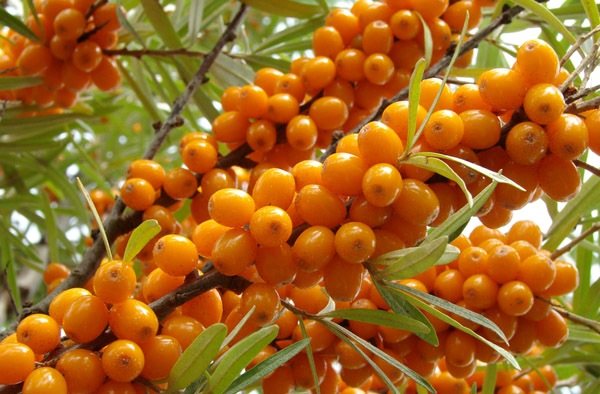

grade Giant
Below is a brief description of popular varieties that have received many positive reviews.
| Variety | Fruit | Productivity, kg / bush | The presence of thorns | Growing area | Ripening period |
| Elizabeth | large juicy bright orange sweet and sour on a long stalk | to 10 | very little | Siberia | early |
| Botanical | large round-oval yellow-orange with a dry separation with a thin skin with sourness on a long stalk | 6 — 7 | very little | North-West, Volgo-Vyatka, Central and North Caucasian regions | early |
| Chuiskaya | large cylindrical orange on the middle stalk sweet-sour | 13 — 22 | very little | in all regions of Russia | early |
| Jam | medium-sized orange-red oval dessert flavor | up to 12 | absent | Siberia | middle |
| Herringbone | small green-lemon sour | average | there are | Has a decorative purpose | late |
| Beloved | medium-sized oval with firm skin, good taste | 12 — 15 | few | Western Siberia, Ural, Central region | early |
| Perchik | medium oval bright orange with pineapple sourness | 6 — 8 | there are | Zoned for the Moscow region and the North-West region | mid-early |
| Altai | large orange oval sweet and sour | moderate and unstable | absent | Siberia | middle |
| Openwork | very large bright orange cylindrical | up to 6 kg | absent | Siberia | middle |
Among all the variety of sea buckthorn varieties, there is no ideal super-variety. One way or another, flaws can be found in anything that is characteristic of any culture. The presented varieties are ideal for growing in a private garden.
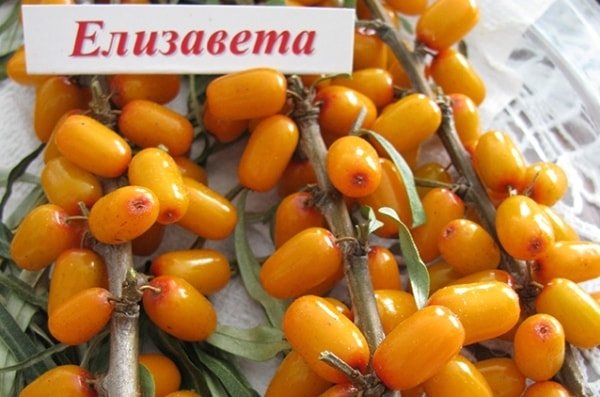

When choosing a variety, be sure to focus on the climatic zone. Ideally, the variety should be locally selected. The description of the variety corresponds to reality only if it is grown in a nominal one in the climatic zone where it was bred.
Soil preparation
Many amateur gardeners believe that the best time to plant sea buckthorn is autumn. There is every reason for this, because the roots of sea buckthorn seedlings, as a rule, have time to take root in the soil before the onset of winter, and after wintering, the soil is saturated with moisture.Saplings prefer floodplain or forest soils, so if there is a heavy clay layer of soil on the site, then it is best to add coarse river sand and phosphate fertilizers to the planting site. Since the absorption area at the roots of sea buckthorn is about 6 m2, then about 1.5 kg of organic fertilizers per 1 m2 should be applied. In the presence of phosphate fertilizers, such as superphosphate, add about 250 grams per m2. Before these procedures, dig up the area well (about 40 cm) and loosen the upper fertile layer.
Transplanting young cuttings
Sea buckthorn can also be transplanted with green young cuttings. This is a fairly effective way. In this case, it is also important to determine where to plant the sea buckthorn. It is recommended to place a ridge of young seedlings under the crown of an adult tree. Here they will not be exposed to direct sunlight. However, the process of propagation by cuttings begins with growing the shoot in greenhouse conditions.
The transplant process is recommended in the summer (early June). To do this, cut a stalk about 15 cm long. Three leaves from the bottom must be removed. Then the cut is recommended to be treated with a growth stimulator. Such solutions are available for sale in specialized stores. Some gardeners do not use it.
For the cutting, it is necessary to prepare a soil mixture, where it will be most advisable to plant sea buckthorn. For this, fertile soil is mixed with sand and peat. It is necessary to grow the plant in greenhouse conditions. The temperature should be around 28 ° C and the humidity should be 90%.
The stalk is regularly watered or sprayed with a spray bottle. When roots appear, you can feed the plant with mineral fertilizers. Then you can begin to gradually ventilate the greenhouse. After 2 months, the film can be removed completely. In the spring, matured cuttings are planted on the site.
How to care? Tips for caring for new plantings
Agrotechnics of caring for new plantings of sea buckthorn includes watering, pruning, loosening and weeding, mulching, feeding, and protection from pests. Gardeners carry out pest control with biological agents, as well as with the help of traps, taking into account the special medicinal value of the plant. The use of chemicals is undesirable. After planting, before winter, the plant is carefully covered: spruce branches, blankets, film, paper are used. The tree is tied to a peg so that it does not break under the pressure of the wind.
Watering and loosening
Initially, sea buckthorn grew near the sea coast, reservoirs. He loves moisture very much. Watering is carried out systematically, but without excessive waterlogging of the soil. With a lack of moisture in the plant, leaves and ovary begin to fall off.
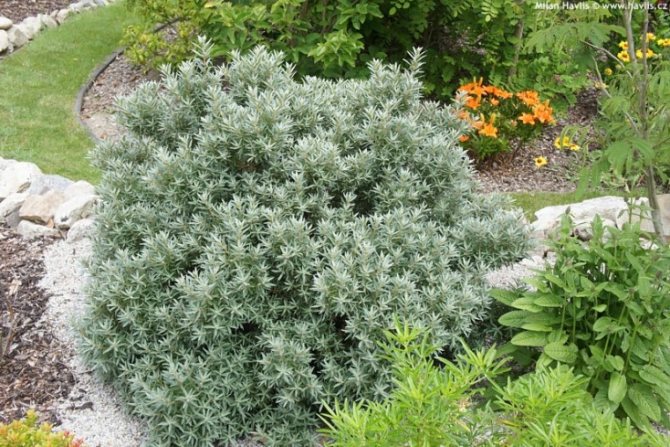

It is especially regularly watered during flowering, ovary formation, fruit growth, and after harvest. During a dry summer, 3-4 buckets are poured under the bush, during fruiting 4-5. Loosening is performed after watering and rains. It should not be deep, since the roots are located close to the ground (7 cm). Avoid digging. When the roots are exposed, they are immediately covered with earth and peat.
Plant feeding
In the first year of development, the culture is not fed. Then top dressing is applied every year in the spring: compost, humus - organic fertilizers in a bucket to the near-stem area. In the second half of the growing season, top dressing is applied, which consists of components, based on a bucket of water:
- urea - 30 gr.
- double superphosphate - 2 tablespoons,
- a spoonful of potassium salt.
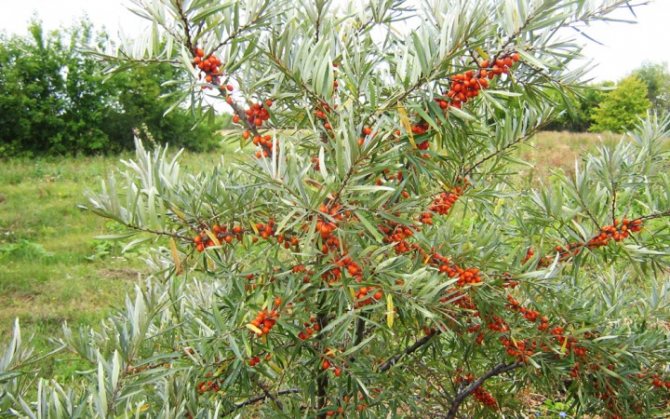

Correct planting of sea buckthorn in autumn and spring: we determine the timing
Sea buckthorn is best planted in the country in the spring, in which case the plant will have time to grow stronger before the onset of cold weather.
Spring planting is usually carried out in late March - early April. It was during this period that the soil is sufficiently moistened, and the shrub is dormant.
But for seedlings with a closed root system, an autumn planting may also be acceptable. Its dates vary from late September to early October. An important condition is a comfortable temperature of +4 degrees.
They plant sea buckthorn after leaf fall, so that the seedling can spend all its energy not on natural processes, but on taking root in a new place.
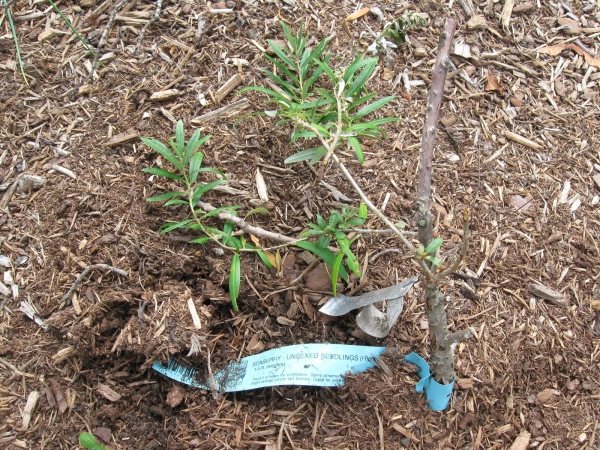

Sea buckthorn is best planted in spring, then the plant will have time to grow stronger before the onset of cold weather
If the dates for planting the bush were missed, then the seedlings need to be dug into the groundso that they can overwinter for later cultivation. To do this, at the highest point of the site, they dig a groove 50-60 centimeters high, and put the seedlings there.
The crown should lie in a southerly direction, this position will help to avoid sunburn. Then the hole is sent with earth and thoroughly watered.
As soon as the cold comes, the plant is completely buried with soil., leaving only the tips of the branches on the surface. To protect against rodents, such a structure is covered with spruce branches from above.
After the appearance of snow, it is carefully tamped around the seedling to create additional protection. When adding several seedlings at once, root plexus should not be allowed.
Advantages and disadvantages spring and autumn planting of sea buckthorn:
| pros | Minuses | |
| Spring |
|
|
| Fall |
|
|

